INFOGRAPHIC: Why large litters could mean higher mortality


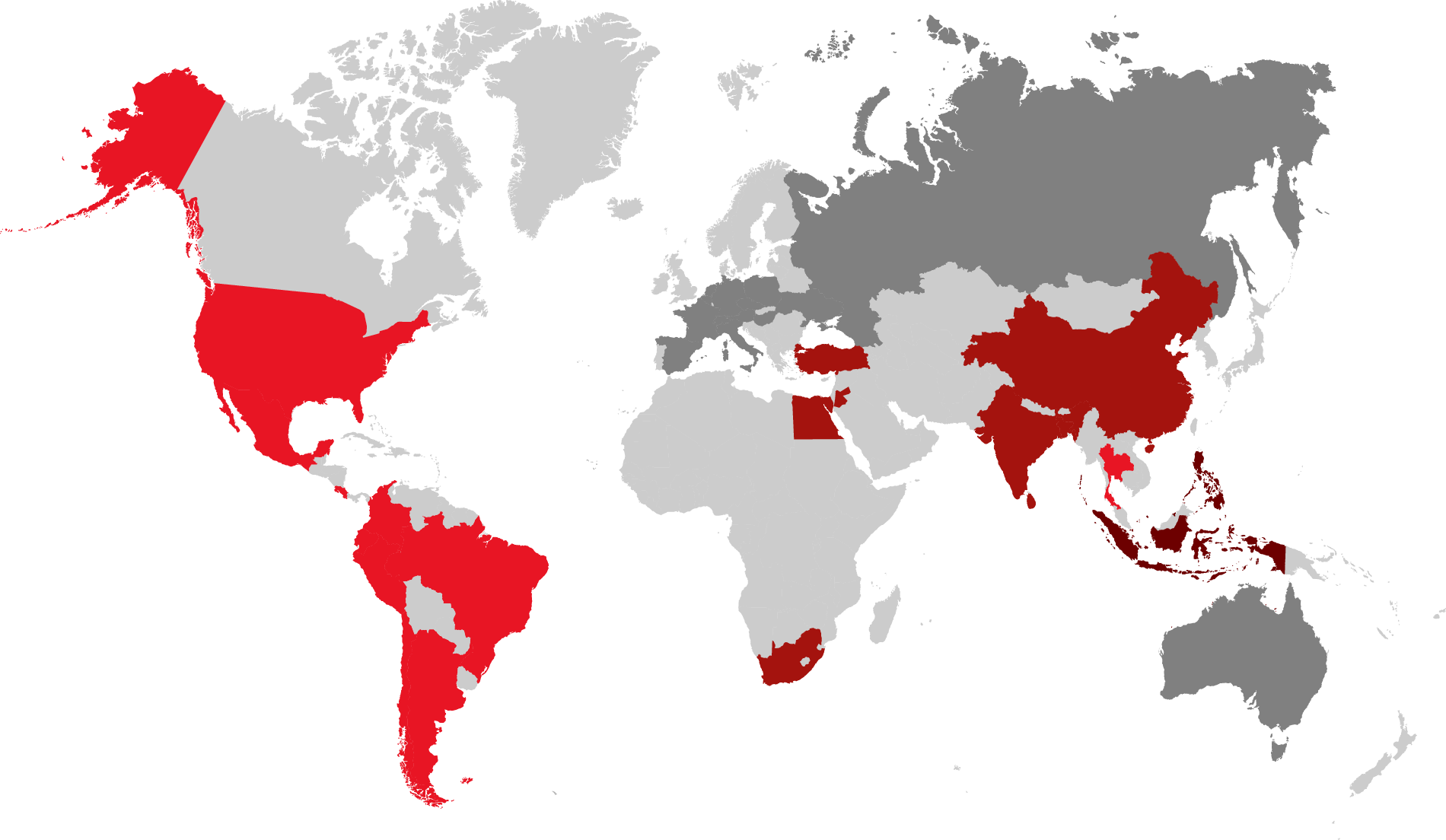
By Technical Team, EW Nutrition
Climate around the globe has changed, increasing atmospheric temperatures and carbon dioxide levels. This change favors the growth of toxigenic fungi in crops and thus increases the risk of mycotoxin contamination. When contaminating feed, mycotoxins exert adverse effects in animals and could be transferred into products such as milk and eggs.
*** Please download the full article for detailed information
Click to see the full-size image
Amongst naturally occurring mycotoxins, the five most important ones are aflatoxin, ochratoxin, deoxynivalenol, zearalenone, and fumonisin. Their incidence varies with the different climates, the prevalence of plant cultures, the occurrence of pests, and the handling of harvest and storage. Worldwide, farmers faced various and sometimes extremely high mycotoxin contamination in their feed materials in 2021. In the following, we show the major challenges in five main regions.
In Asia, high temperatures and humidity favor Aspergillus growth in grains. As a result, 95 % of the samples in South Asia and three-quarters of the samples in the China and the SEAP region (Indonesia, Philippines, Vietnam) showed aflatoxin contamination. The average contamination being higher than the threshold for all farm animals represents an increased risk for their health and performance.
In China and the SEAP region, also DON and T-2 were highly prevalent. Showing an incidence of more than 60%, they pose a severe risk when combined with aflatoxin.
In Mexico, Central and South America, fumonisin contamination prevailed with an incidence of almost 90% at average levels that can be considered risky for swine and dairy. Together with incidence levels of around 60% found for DON and T2, fumonisin may act synergically in the animals, raising the risk for health and performance.
The Fusarium species linked to these mycotoxin contaminations occur in the grains on the field. Amongst others, insect damage, droughts during growing, and rain at silking favor their development.
Contamination with trichothecenes (DON and T2) is the rule in the United States. The interaction of these mycotoxins is at least additive. The damage they cause to the gut opens the door to dysbiosis and disease, decreasing performance and profitability.
Also in this case, the responsible molds for the contamination are Fusarium species that develop when grains are in the field. As with fumonisins, the molds are favored by insect damage, moderate to warm temperatures and rainfall.
Fusarium toxins such as Fumonisin, DON, and T2 prevail in the region of Egypt, Jordan, and South Africa. In combination, these mycotoxins have additive effects at the intestinal level, which increases the risk of dysbiosis in poultry.
Since mycotoxin contamination affects animal health, measures must be taken to provide the best protection. Besides improving agricultural practices in the field, smart in-feed solutions and mold inhibitors can be used in stored grain. These measures help producers preserve feed quality after a troubled year for crops around the world.
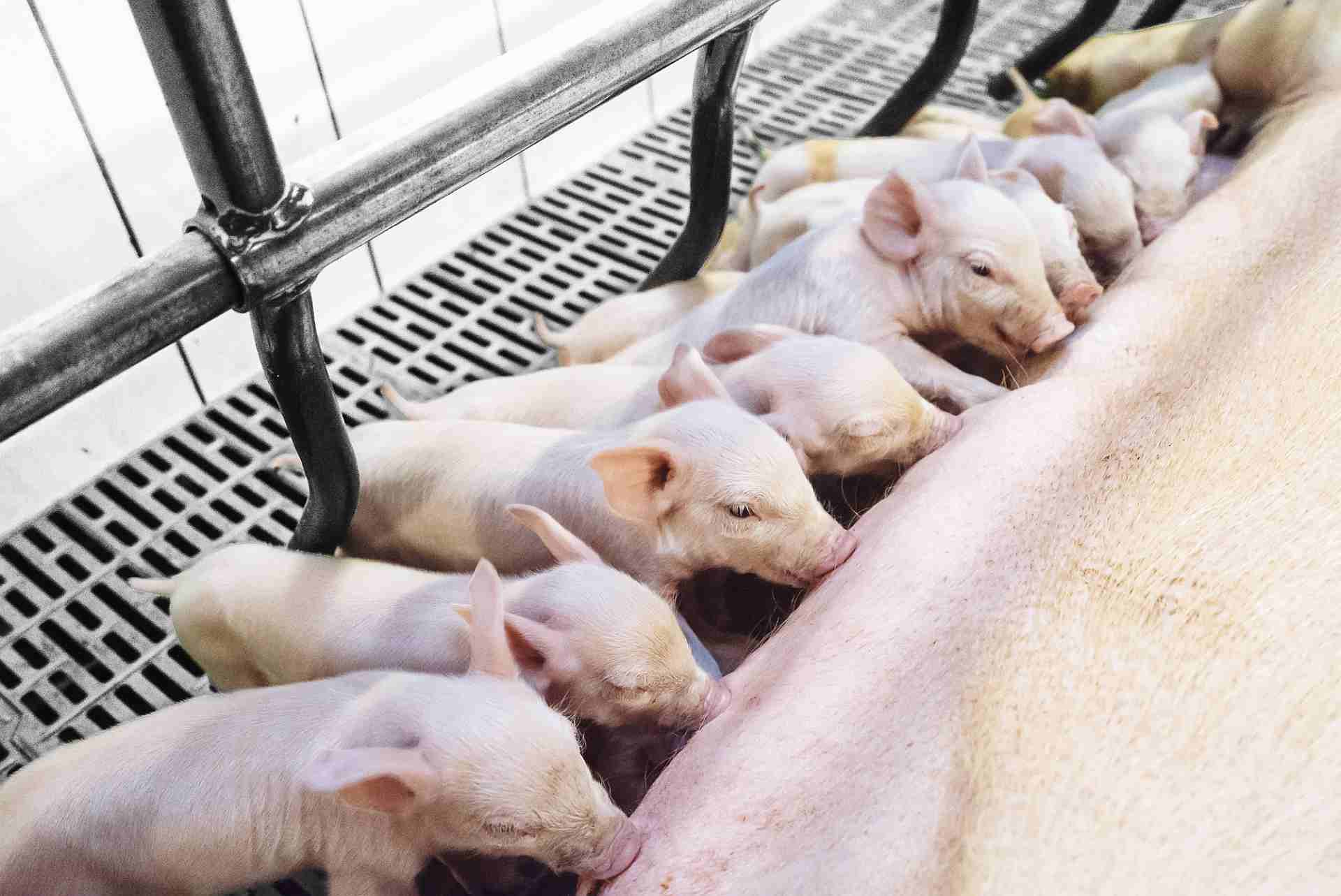
By Technical Team, EW Nutrition
As pig production specialists, we understand that our animals are under constant challenge during their life. Challenges can be severe or moderate, correlated to several factors – such as, for instance, stage of production, environment, and so on – but they will always be present. To be successful, we need to understand how to counter these challenges and support the healthy development of our pigs.
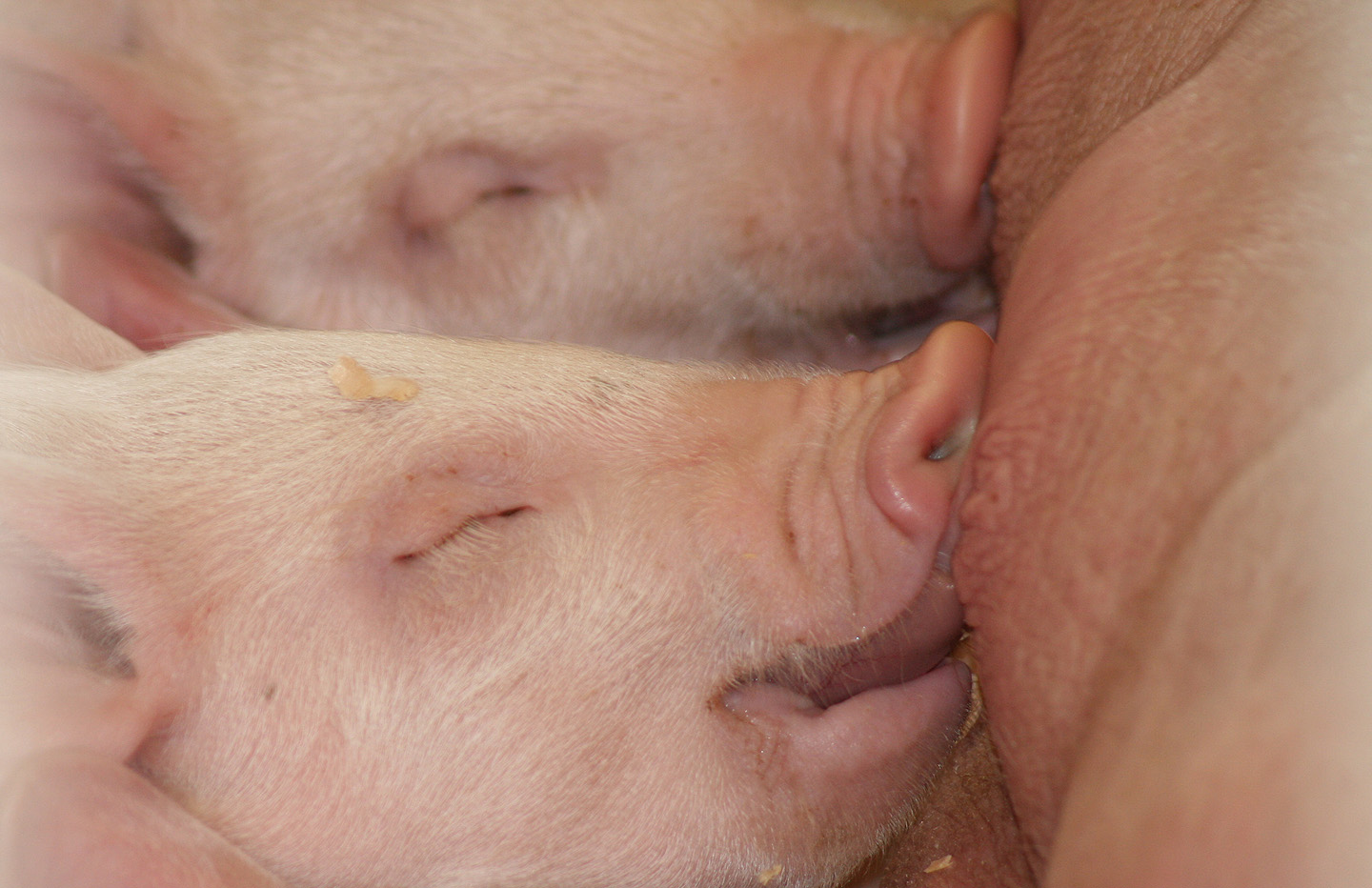
For years we have been increasing our understanding of how to formulate diets to support a healthy intestine through the optimal use of the supplied nutrients. Functional proteins, immune-related amino acids, and fiber are now applied worldwide for improved pig nutrition.
However, pig producers have also realized that these nutritional strategies alone are not always fully efficient in preventing an “irritation” of the immune system and/or in preventing diseases from happening.
Immune nutrition is gaining a strong foothold in pig production, and the body of research and evidence grows richer every year. At the same time, we see genetics continually evolving and bringing production potential to increasingly higher levels. We are also constantly increasing our understanding of the importance of farm and feed management, as well as biosecurity in this process.
Finally, the importance of a stable microflora is now uncontested. Especially around weaning, a stable microflora is necessary to prevent the proliferation of pathogens such as E.coli bacteria. Such pathogens can degrade the lysine (the main amino acid for muscle protein production) we have added to our formulations, rendering it useless.
Single molecules (or additives) are able to support the development of gut microflora, boost its integrity, and therefore help the animals use “traditional nutrients” in a more effective way.
Animal performance is influenced by complex processes, from metabolism to farm biosecurity. Environmental conditions, diet formulation and feed management, and health status, among others, directly affect the amount of the genetic potential that animals can effectively express.
Among these so-called non-genetic variables, health status is one of the most decisive factors for the optimal performance from a given genotype. Due to the occurrence of (sub-) clinical diseases, the inflammatory process can be triggered and may result in a decrease in weight gain and feed efficiency.
Not so long ago, pig producers believed that a maximized immune response would always be ideal for achieving the best production levels. However, after decades spent researching what this “maximized immune response” could mean to our pigs, studies from different parts of the globe proved that an activated immune system could negatively affect animal performance. The perception is nowadays common sense within the global pig production industry.
That understanding led us to increasingly search for production systems that will yield the best conditions for the pigs. This means minimum contact with pathogens, reduced stress factors, and therefore a lower need for an activated immune system.
The immune system has as main objective to identify the presence of antigens – substances that are not known to the body – and protect the body from these “intruders”. The main players among these substances are bacteria and viruses. However, some proteins can also trigger an immunological reaction. Specific immune cells are responsible for the transfer of information to the other systems of the body so that it can respond adequately. This response from the immune system includes metabolic changes that can affect the demand for nutrients and, therefore, the animals’ growth.
The stimulation of the immune system has three main metabolic consequences:
In general, the immune system responds to antigens, releasing cytokines that activate the cellular (phagocytes) and humoral components (antibody), resulting in a decreased feed intake and an increased body temperature/heat production.
When feed formulation is concerned, possibly even more important is to understand that the activation of the immune system leads to a change in the distribution of nutrients. The basal metabolic rate and the use of carbohydrates will have completely different patterns in such an event. For instance, some glucose supplied through the feed follows its course to peripheral tissues; however, part of the glucose is used to support the activated immune system. As a consequence, the energy requirement of the animal increases.
Protein synthesis and amino acid utilization also change during this process. There is a reduction of body protein synthesis and an increased rate of degradation. The nitrogen requirement increases because of the higher synthesis of acute-phase proteins and other immunological cells.
However, increased lysine levels in the diets will not always help the piglets compensate for this shift in the protein metabolism. According to Shurson & Johnston (1998), when the immune system is activated, there is further deamination of amino acids and increased urinary excretion of nitrogen. Therefore we need to understand better which amino acids must be supplied in a challenging situation.
In pigs, the gastrointestinal tract is, to a large extent, responsible for performance. This happens because the gut is the route for absorption of nutrients, but also a reservoir of hundreds of thousands of different microorganisms – including the pathogenic ones.
Gut health and its meaning have been the topic of several peer-reviewed articles in the last few decades (Adewole et al., 2016, Bischoff, 2011, Celi et al., 2017, Jayaraman and Nyachoti, 2017, Kogut and Arsenault, 2016, Moeser et al., 2017, Pluske, 2013). Despite the valuable body of knowledge accumulated on the topic, a clear and widely-accepted definition is still lacking. Kogut and Arsenault (2016) define it in the title of their paper as “the new paradigm in food animal production”. The authors explain it as the “absence / prevention / avoidance of disease so that the animal is able to perform its physiological functions in order to withstand exogenous and endogenous stressors”.
In a recently published paper, Pluske et al. (2018) add to the above definition that gut health should be considered in a more general context. They describe it “a generalized condition of homeostasis in the GIT, with respect to its overall structure and function”. The authors add to this definition that gut health in pigs can be compromised even when no clinical symptoms of disease can be observed. Every stressful factor can undermine the immune response of pigs and, therefore, the animals’ performance.
All good information on this topic leads us to the conclusion that, without gut balance, livestock cannot perform as expected. Therefore, balance is the objective for which we formulate our pigs’ feed.
The photos included here were taken in the field and show that taking action against this reality is a must for keeping animals healthy.
Much of this action is related to farm management. The most effective way to minimize such situations is to implement a strict control system in the feed production sites, including controlling raw material quality.
Additives can be used to improve the safety of raw materials. As already extensively discussed, everything that goes into the intestine of the animals will affect gut health and performance. Therefore, the potential harmful load of mycotoxins should be taken into account. Besides careful handling at harvest and the proper storage of grains, mycotoxin binders can be applied to further decrease the risk of mycotoxin contamination.
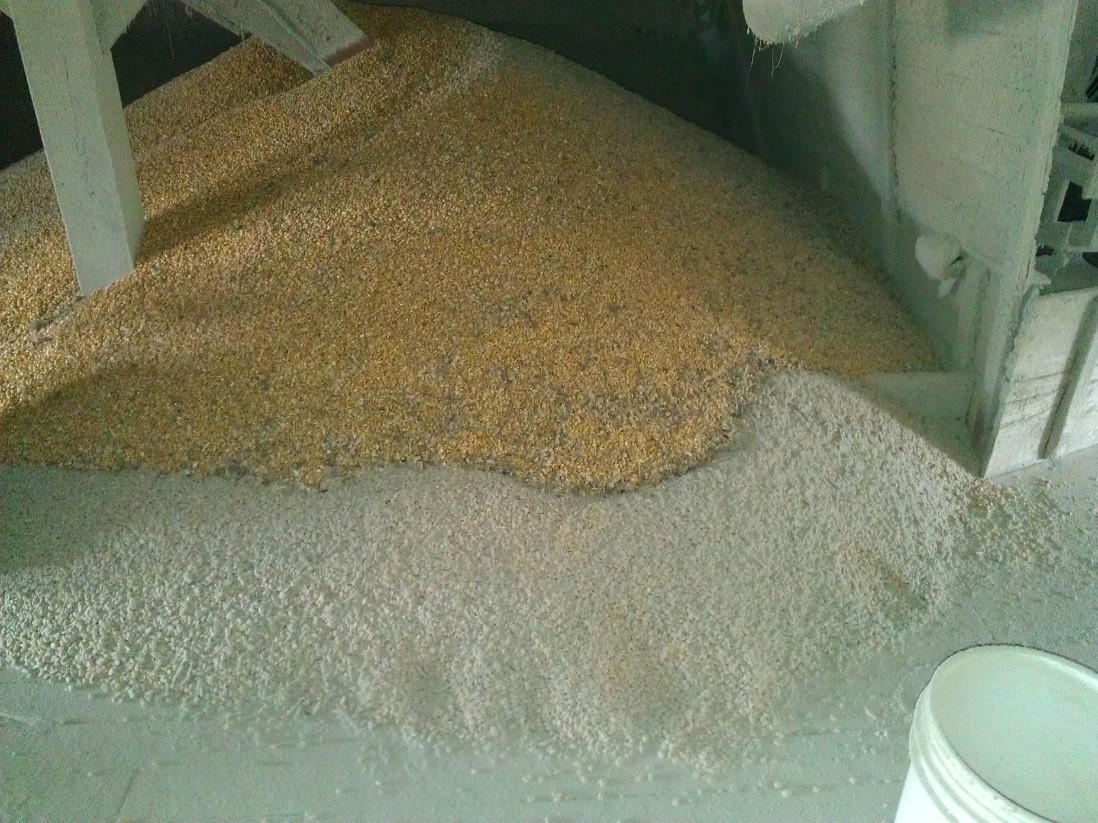

The gut-health-focused formulation of diets must take into account the following essentials:
A lower pH in the stomach slows the passage rate of the feed from the stomach to the small intestine. A longer stay of the feed in the stomach potentially increases the digestion of starch and protein. The secretion of pancreatic juices stimulated by the acidic stomach content will also improve the digestion of feed in the small intestine.
For weaned pigs, it is essential that as little as possible of the substrate will reach the large intestine and be fermented. Pathogens take advantage of undigested feed to proliferate. Lowering these “nutrients” will decrease the risk of bacterial overgrowth.
The same is true where protein sources and their levels are concerned. It is essential to reduce protein content as much as possible and preferably use synthetic (essential) amino acids. The application of such sources of amino acids has been proven long ago, and yet in some cases, it is still not fully utilized. Finally, using highly digestible protein sources should, at this point, be a matter of mere routine.
All these strategies have the same goal: the reduction of undigested substances in the gut. Additionally, the reduction of the protein levels can also decrease the costs of the diets.
Further diet adjustments, such as increasing the sulfur amino acids (SAA) tryptophan and threonine to lysine ratio, must also be considered (Goodband et al., 2014; Sterndale et al., 2017). Although the concept of better balancing tryptophan and threonine are quite clear among nutritionists, SAA are sometimes overestimated. Sulfur amino acids are the major amino acids in proteins related to body maintenance, but not so high in muscle proteins. Therefore, the requirement of SAA must also be approached differently. Unlike lysine, the requirements of SAA tend to be higher in immunologically stimulated animals (Table 1).
| Pig weight (kg)
|
ISA* | SID Lysine (%) | SAA (%) | SAA:Lys |
| 9 | High | 1,34 | 0,64 | 0,48 |
| Low | 1,07 | 0,59 | 0,55 | |
| 14 | High | 1,22 | 0,62 | 0,51 |
| Low | 0,99 | 0,57 | 0,58 |
Table 1. Effect of the immune system activation on the demand for lysine and sulfur amino acids in pigs (Stahly et al., 1998)
*ISA – immune system activation
Vitamins and minerals are classic nutrients to be considered when formulating gut health-related diets. Maybe not so extensive as the amino acids and protein levels, these nutrients have, however, been found to carry benefits in challenging situations. In the past several years, a lot was published on the requirements of pigs facing an activation of the immune system. Stahly et al. (1996) concluded that when the immune system is activated, the phosphorous requirements change.
| Parameters
|
ISA* | |
| High | Low | |
| Feed intake (g/d) | 674 | 833 |
| Weight gain (g/d) | 426 | 566 |
| Available P (%) | 0,45 | 0,65 |
Table 2. Effect of the immune system activation on the performance and phosphorous requirements of pigs (Stahly et al., 1998)
*ISA – immune system activation
Another example is vitamin A. It is involved in the function of macrophages and neutrophils. Vitamin A deficiency decreases the migratory and phagocytic abilities of the immune cells. A lower antibody production is observed in vitamin A deficiency as well. Furthermore, vitamin A is an important factor in mucosal immunity, because this vitamin plays a role in lymphocyte homing in the mucosa (Duriancik et al., 2010).
Phytomolecules are currently considered one of the top alternatives to in-feed antibiotics for pigs worldwide. Programs sponsored by the European Union are once more evaluating the effectiveness of these compounds as part of a strategy to produce sustainable pigs with low or no antibiotic use. The EIP-Agri (European Innovation Partnership “Agricultural Productivity and Sustainability”) released a document with suggestions to lower the use of antibiotics in feed by acting in three areas:
Under the last topic, the commission recommends plant-based feed additives to be further examined.
Antibiotics have been used for many years for supporting performance in animal production, especially in critical moments. The mode of action consists of the reduction of pathogen proliferation and inflammation processes in the digestive tract. These (soon-to-be-) banned compounds therefore reduce the activation of the immune system, helping keep pigs healthy through a healthy gastrointestinal tract. As potential alternatives to antibiotic usage, phytomolecules should be able to do the same.
Most phytomolecules used nowadays aim to control the number and type of bacteria in the gut of animals. According to Burt (2004), the antimicrobial activity of phytomolecules is not the result of one specific mode of action, but a combination of effects on different targets of the cell. This includes disruption of the membrane by terpenoids and phenolics, metal chelation by phenols and flavonoids, and protective effects against viral infections for certain alkaloids and coumarins (Cowan, 1999).
The antimicrobial efficacy is one of the most important activities of secondary plant compounds, but it also impacts digestion. Windisch et al. (2008) states that growth-promoting agents decrease immune defense stress during critical situations. They increase the intestinal availability of essential nutrients for absorption, thus promoting the growth of the animal.
Indeed, phytomolecules are a good tool for stabilizing the gut microbiota. But more can be expected when adding this class of additives into your formulation and/or farm operations. Mavromichalis, in his book “Piglet Nutrition Notes – Volume 2”, brings attention to the advantages of using phytomolecules such as capsaicin, which is often related to increased feed intake. Recent research has demonstrated that capsaicin increases the secretion of digestive enzymes that may result in enhanced nutrient digestibility. According to Mavromichalis, this can lead to a better feed conversion rate as more nutrients are available to the animal. Indirectly, this also helps control the general bacterial load in the gut.
This results from the polyphenols’ capacity to act as metal-chelators, free radical scavengers, hydrogen donators, and inhibitors of the enzymatic systems responsible for initiating oxidation reaction. Furthermore, they can act as a substrate for free radicals such as superoxide or hydroxyl, or intervene in propagation reactions.
This variety of benefits explains at least partially the high level of interest in this group of additives for pigs under challenging conditions. For the production of effective blends, it is crucial to understand the different modes of action of the phytomolecules and the probable existing synergies. Furthermore, the production technology must be considered. For instance, microencapsulation techniques that prevent losses during feed processing are an important consideration.
The recent outbreak of African Swine Fever focused our attention on something that is sometimes neglected on the farm: biosecurity rules. According to the report “Good Practices For Biosecurity In The Pig Sector” (2010), the three main elements of biosecurity are:
In general terms, the following steps must be adopted with the clear goal of reducing the challenges that the pigs are facing.
These simple actions can make a big difference to the performance of the pigs, and as a consequence to the profitability of a swine farm.
Different formulations and reassessed nutritional level recommendations have been on the radar for a couple of years. It is high time to consider using efficient additives to support the pigs’ gut health. Phytomolecules appear as one of the most prominent tools to reduce pathogenic stress in pig production. Either via feed or water, phytomolecules are proven to reduce bacterial contamination and therefore reduce the need for antibiotic interventions. Furthermore, a more careful look at our daily activities in the farm is crucial. Paying attention to biosecurity and to feed safety should be standard tools to improve performance and the success of pig production operations.
References are available upon request.
*The article was initially published in the PROCEEDINGS OF THE PFQC 2019

By Technical Team, EW Nutrition
Secondary plant extracts have been shown to improve digestion, have positive effects on intestinal health, and offer protection against oxidative stress in various scientific studies in recent years. Their use as a feed additive has become established and various mixtures, adapted to the various objectives, are widely available.
However, their use in pelleted feed has been criticized for some time. In particular, an unsatisfactory reproducibility of the positive influences on performance parameters is the focus of criticism. The causes invoked for the loss of quantifiable benefits are inadequately standardized raw materials, as well as uncontrollable and uneven losses of the valuable phytomolecules contained during compound feed production.
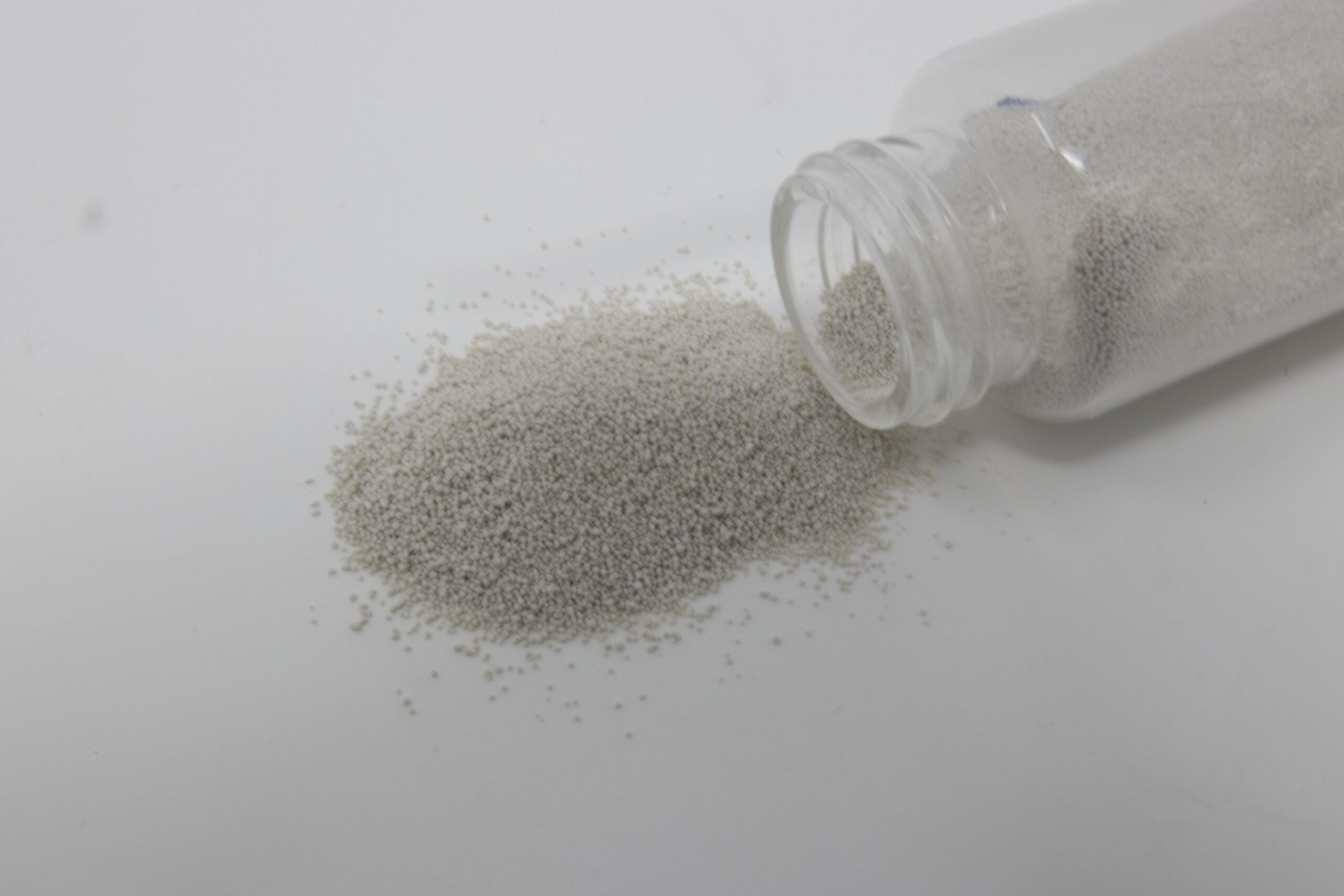
The animal production industry has long attempted to reduce its need for antibiotic drugs to an indispensable minimum. As a result, more natural and nature-identical feed additives have been used for preventive health maintenance. These categories include numerous substances that are known in human nutrition in the field of aromatic plants and herbs, or in traditional medicine as medicinal herbs.
The first available products of these phytogenic additives were simply added to compound feed. The desired parts of the plant were, like spices and herbs in human nutrition, crushed or ground into the premix. Alternatively, liquid plant extracts were placed on a suitable carrier (e.g. diatomaceous earth) beforehand in order to then incorporate them into the premix. These procedures are usually less than precise and may be responsible for the difficult reproducibility of positive results mentioned at the beginning.
Another negative factor that should not be underestimated is the varying concentration and composition of the active substances in the plant. This composition is essentially dependent on the site conditions, such as weather, soil, community and harvest time [Ehrlinger, 2007]. In an oil obtained from thyme, the content of the relevant phenol thymol can therefore vary between 30% and 70% [Lindner, 1987]. These extreme fluctuations are avoided with modern phytogenic additives through the use of nature-identical ingredients.
The loss of valuable phytomolecules under discussion can also be traced back to the natural origin of the raw materials. Some phytomolecules (e.g. cineole) are volatile even at low temperatures. In regular medicinal use, this effect is mainly employed with cold products. Thus essential oils, such as of mint and eucalyptus, can be added to hot water and inhaled via the resultant steam.
In the process of pelleting in compound feed production, temperatures between 60°C and 90°C are common, depending on the type of production. The process can last for several minutes until the cooling process is over. Sensitive additives can be easily inactivated or volatilized during this step.
A technical solution for the preservation of temperature-sensitive additives is using a protective cover. This is, for instance, an already established practice for enzymes. Such so-called encapsulation is already used successfully in high-quality products with phytogenic additives. The volatile substances should be protected by a coating with fat or starch so that the majority (>70%) of the ingredients can also be found after pelleting.
Unfortunately, complete protection is not possible with this capsule, as this simple protective cover can be broken open by mechanical pressure during grinding and pelletizing. New types of microencapsulation further reduce losses. In a sponge-like type of microencapsulation, if a capsule is destroyed, only a small proportion of the chambers filled with volatile phytomolecules are damaged.
A new type of encapsulation, developed by EW Nutrition for use in feed, delivers further optimization. Results show that the technology implemented in Ventar D ensures very high recovery rates of the sensitive phytomolecules even under demanding pelleting conditions.
In a comparative study with encapsulated products established on the market, Ventar D was able to achieve the highest recovery rates in all three tested scenarios (70°C, 45 sec; 80°C, 90 sec; 90°C, 180 sec). In the stress test at a temperature of 90°C for 180 seconds, at least 84% of the valuable phytomolecules were recovered, while the comparison products varied between 70% and 82%. A constant recovery rate of 90% was achieved for Ventar D under simpler conditions.
Phytomolecule recovery rates under processing conditions, relative to mash baseline (100%)
The major gastrointestinal pathogens (like Clostridia spp., Salmonella spp., E. coli, etc.) are present across the gastrointestinal tract after the proventriculus. This leads to infection or lesions at different sites of preference, reaching up to ceca. Any feed-based solution should have a profound antimicrobial effect. It is, however, also crucial that active ingredients are released across the gastrointestinal tract, for a better contribution to intestinal health.
The unique, innovative delivery system used for Ventar D specifically addresses this point, which many traditional coating technologies do not. Other encapsulation technologies tend to release the active ingredient either too early or too late (depending on the coating composition). The active ingredients in Ventar D reach across sites in the gastrointestinal tract and exert antimicrobial effects, supporting optimal gut health and improving performance.
In the past, the losses mentioned in compound feed production and especially in pelleting were described as largely unavoidable. To obtain the desired effect of the valuable phytomolecules in the finished product, higher use of products was recommended and thus increased costs to the end-users and the associated CO2 footprint, lowering sustainability overall.
The modern encapsulation technology used in Ventar D now offers significantly better protection for the valuable phytomolecules and, in addition to the economic advantage, also offers more efficient use of the resources required for production.
Hashemi, S. R .; Davoodi, H .; 2011; Herbal plants and their derivatives as growth and health promoters in animal nutrition; Vet Res Commun (2011) 35: 169-180; DOI 10.1007 / s11259-010-9458-2; Springer Science + Business Media BV, 2011
Ehrlinger, M., 2007: Phytogenic additives in animal nutrition. Inaugural dissertation. Munich: Veterinary Faculty of the Ludwig Maximilians University in Munich.
Lindner, U., 1987: Aromatic plants – cultivation and use. Contribution to the special show – Medicinal and Spice Plants (Federal Garden Show 1987), Teaching and Research Institute for Horticulture Auweiler-Friesdorf, Düsseldorf.
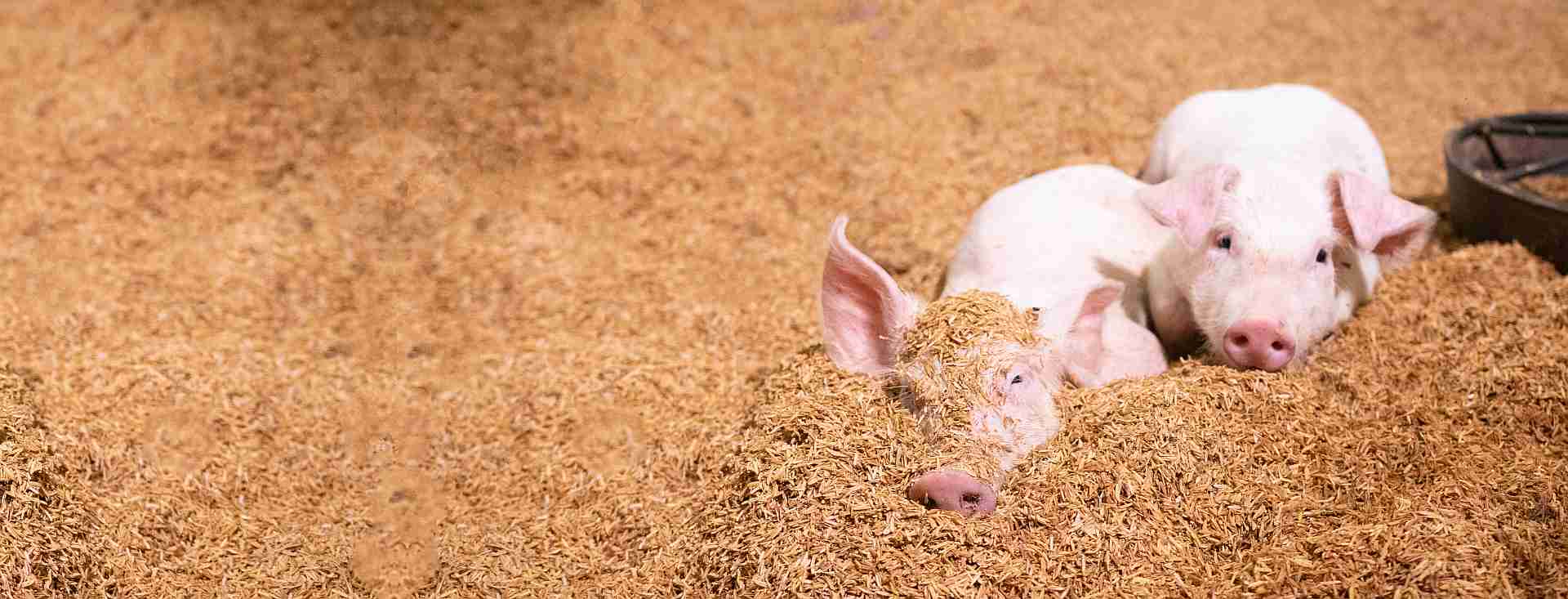
By Technical Team, EW Nutrition
In modern swine production, one of the key aspects for success is a balanced diet. This essentially means ensuring that the animal meets its daily nutritional requirements for maintenance, growth, and reproduction. In order to provide an appropriate diet and safe feed for the animals, the sensory and nutritional characteristics of the feed must be preserved and issues like the oxidation of the feed must be avoided.
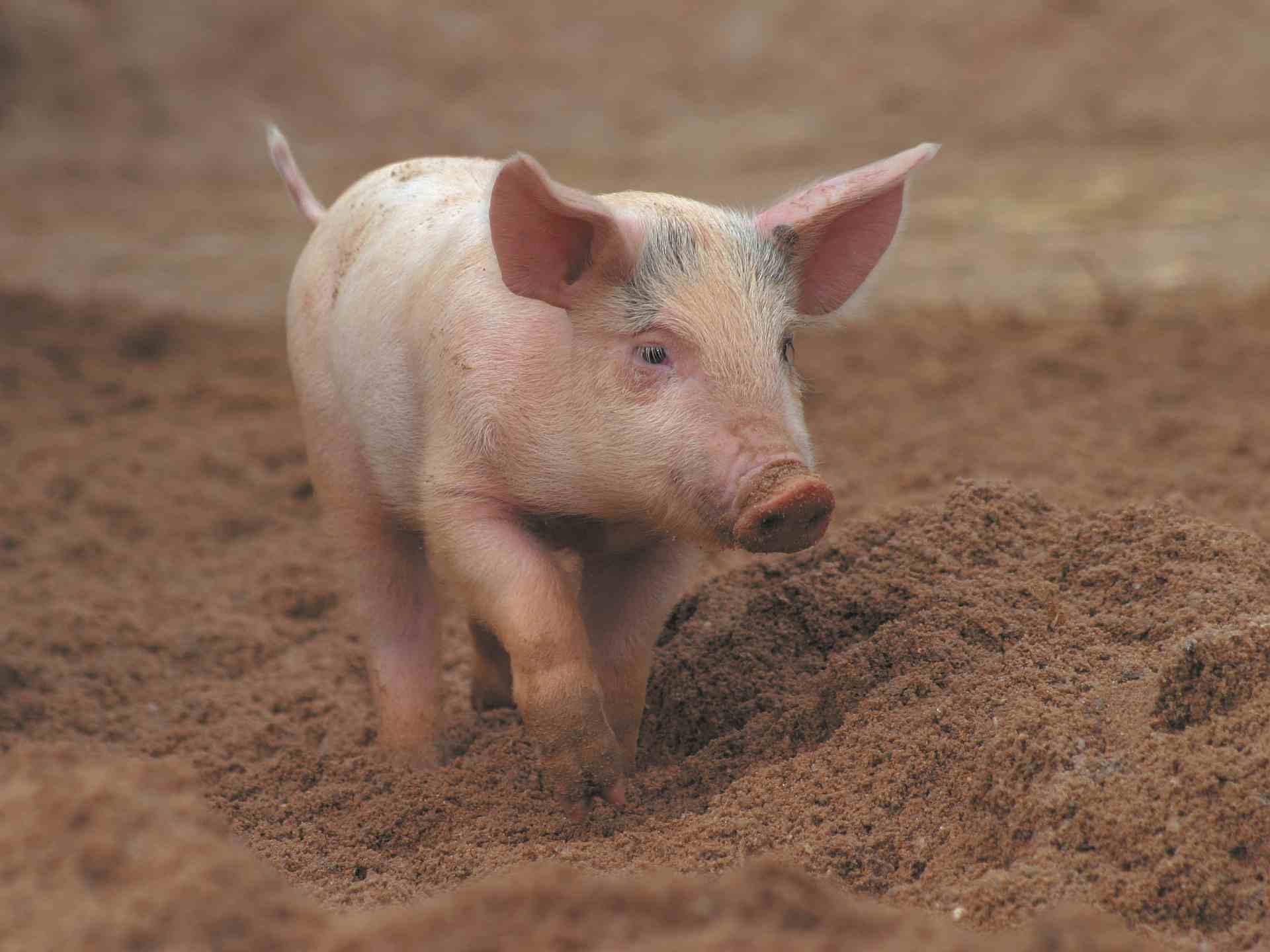
This article aims to highlight why oxidation in feed can become a big concern for swine producers, what the problems resulting from oxidation in pig feed are, and present practical solutions to improve feed quality and pig performance by controlling the oxidation.
In pig diets, various sources of lipids are added to increase caloric density, provide essential fatty acids, improve feed palatability, improve pellet quality, and reduce dust (Keer et al., 2015). Some of the feed ingredients are more susceptible to oxidation because of their physical and chemical characteristics, such as milled grains and ingredients of animal origin and vegetable oils with a high content of polyunsaturated fatty acids.
Oxidative rancidity is a type of lipid deterioration. In the oxidation process, the free radicals react with lipids and proteins and induce cellular and tissue damage.
Some consequences of oxidative deterioration are the destruction of fat-soluble vitamins, supplemental fats, and oils. Preserving these ingredients is crucial because fats and oils provide a high quantity of energy and essential fatty acids. At the same time, vitamins, such as those present in vitamin premixes, are indispensable for optimal animal growth and performance.
The oxidation process also results in by-products with strong unpleasant taste and odor, and even toxic metabolites. In addition, oxidized feed has less protein, amino acids, and energy content. All these factors are relevant when resources, in the current scenario of high prices of feed ingredients and inputs, might be wasted due to poor feed management.
Lipid oxidation can incur several losses regarding the pigs’ performance. Feeding oxidized lipids significantly decreases growth rate, feed intake and efficiency, immune function, and weight gain efficiency in pigs, especially in breeding animals, since the exposure occurs over long periods.
The ingestion of products resulting from the oxidative deterioration of fatty acids leads to irritability of the intestinal mucosa, diarrhea, and, in extreme cases, can result in liver degeneration and cell death. DeRouchey et al. (2004) observed reduced growth rates in pigs that are fed rancid white grease. Ringseis et al. (2007) reported that feeding oxidized sunflower oil increased oxidative stress markers in the small intestine of pigs, while Boler et al. (2012) reported that feeding pigs oxidized corn oil reduced growth performance (Table 1). Lu et al. (2014a) reported signs of liver damage in pigs subjected to dietary oxidative stress, increasing plasma bilirubin content, and enlarged liver size.
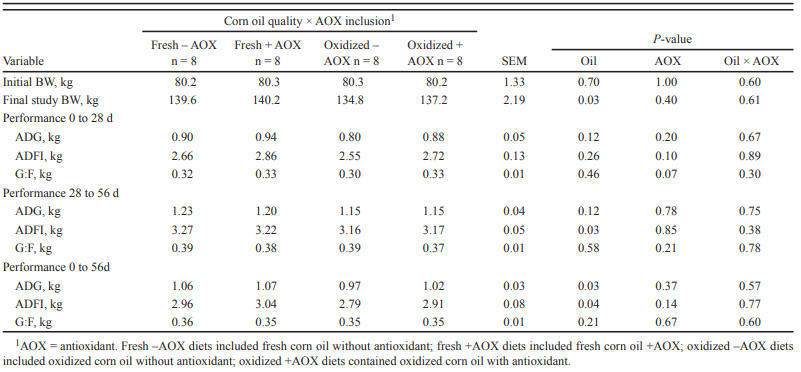
Table 1. Effects of dietary corn oil quality and antioxidant inclusion on barrow performance (Source: Boler et al., 2012)
There are some theories as to why oxidized feed causes such effects. According to Dibner et al. (1996), vitamins and polyunsaturated fatty acids deteriorate in the absence of antioxidants, and oxidized fats and their byproducts can negatively affect cells, resulting in changes in membrane permeability, viscosity, secretory activity, and membrane-bound enzyme activity. These primary effects lead to observable systemic effects. In order to prevent these damaging consequences, antioxidants have become a widely used alternative.
Chemical antioxidants (Table 2) are added to animal feeds to delay fat and vitamin oxidation, which keeps the diet palatable and helps prolong the feed’s shelf life, ultimately maintaining the quality of the ingredients (Jacela et al., 2010). They prevent the binding of oxygen to free radicals. Dietary antioxidants have also been used in several species of animals to replace vitamin E, which is known for its antioxidant powers. Antioxidants are highly applicable in warm climates, when high levels of fat are added to the diet, and in areas where byproducts high in unsaturated fats are commonly used.

Table 2. Commonly used chemical antioxidants
Lu et al. (2014b) studied the effects of dietary supplementation with a blend of antioxidants (ethoxyquin and propyl gallate) on carcass characteristics, meat quality, and fatty acid profile in finishing pigs fed a diet high in oxidants. They reported that the inclusion of antioxidants minimized the effects of the high oxidant diet. The treatments including antioxidants, whether combined with vitamin E or not, had positive results in carcass weight, back fat, loin characteristics, and extractable lipid percentage.
Fernandez-Duenas (2009) studied the use of antioxidants in feed containing fresh or oxidized corn oil and its effects on animal performance, the oxidative status of tissues, meat quality, shelf life, and the antioxidant activity of skeletal muscle of finishing pigs. They reported that barrows fed with diets with the antioxidant blend showed increased feed efficiency. Orengo et al. (2021) showed that feeds protected with antioxidants could compensate for low vitamin E supply with regard to growth performance in the starter phase. Hung et al., 2017 theorized that the impacts on growth performance are likely related to the lack of adequate antioxidant capacity of the diet and oxidative stress status.
As literature and application results show, the use of antioxidants in pig feed is crucial to minimize adverse effects from oxidized feed and allow the animals to express their full performance potential.
From a practical standpoint, swine producers must consider some criteria for selecting a good antioxidant, which must preserve feed components, be nontoxic for humans and pigs, show effectiveness at very low concentrations, and be economically sustainable.
Considering those major characteristics, EW Nutrition offers a range of antioxidant solutions for the preservation of feed ingredients and feeds for poultry and swine through their SANTOQUIN product line. Santoquin is a feed preservative that protects supplemental fats, oils, meals, and vitamin premixes and protect feed from oxidation. Santoquin provides unsurpassed protection from oxidative rancidity, and it has proven effects against oxidation in feeds (Figure 1) ensuring the prolonged shelf life of feeds, especially during suboptimal storage conditions, such as those with high environmental temperature and elevated levels of moisture.
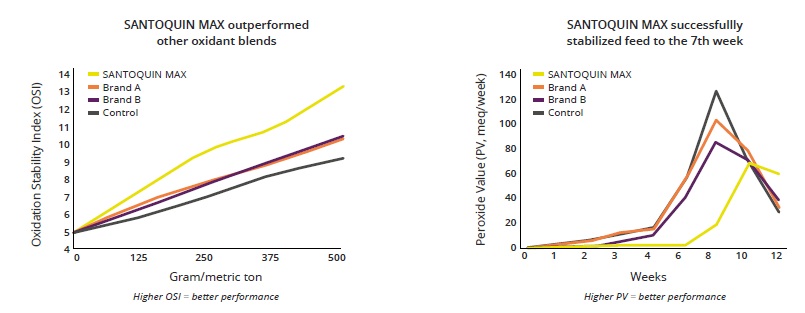
Figure 1. Antioxidant efficacy and competitiveness. SANTOQUIN MAX feed preservative is a proprietary antioxidant blend that effectively prolongs the shelf life of feed and feed ingredients by reducing oxidation rate.
Studies have been conducted to show the beneficial effects of Santoquin. Ethoxyquin, contained in Santoquin, has been used in the swine industry for over five decades and has been shown to improve growth performance and markers of oxidative status in pigs (Dibner et al., 1996). Ethoxyquin is also known for being the most efficacious and cost-effective antioxidant. Lu et al. (2014b) showed that the addition of an antioxidant blend (ethoxyquin and propyl gallate) protected pigs fed with a high-oxidant diet from oxidative stress more efficiently than vitamin E supplementation (Figure 2).
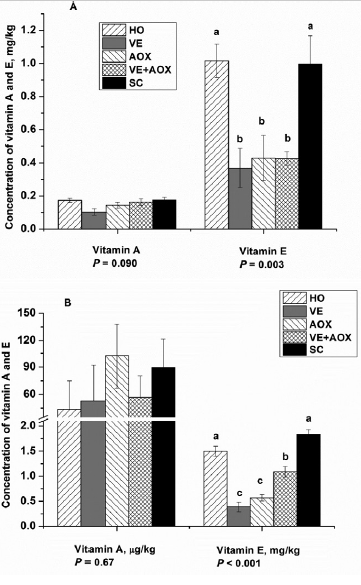
Figure 2. Concentrations of vitamins A and E across treatments in the plasma (A) and muscle (B). HO: high oxidant diet containing 5% oxidized soybean oil (peroxide value at approximately 180 mEq/kg of oil, 9 mEq/kg in the diet) and 10% of a PUFA source (providing approximately 55.57% of crude fat that contains docosahexaenoic acid [ DHA] at 36.75%, and 2.05% DHA in the diet); VE: the HO diet with 11 IU/kg of added vitamin E; AOX: the HO diet with an antioxidant blend (ethoxyquin and propyl gallate, 135 mg/kg); VE+AOX: the HO diet with both vitamin E and antioxidant blend; SC: a standard corn–soy control diet with nonoxidized oil and no PUFA source. The HO pigs were switched to the SC diet after day 82 as an intervention for poor health and performance. The samples came from two pigs from each pen. The VE treatment lost 1 replicate during the feeding phase and transportation period (n = 4), while in other treatments, n =5. (Source: Lu et al., 2014b)
The negative effects of oxidation in pig feed can result in diets with lower biological energy value. To avoid that, antioxidants help maintain intestinal health, ensure a safe food intake, preserve the ingredients and resources used in pig production. Overall, antioxidants help swine producers improve feed conversion and achieve more productive animals and lower mortality caused by toxicity. At the end of the day, the use of antioxidants is associated with better profitability.
References
Boler, D. D., Fernández-Dueñas, D. M., Kutzler, L. W., Zhao, J., Harrell, R. J., Campion, D. R., Mckeith, F. K., Killefer, J., & Dilger, A. C. (2012). Effects of oxidized corn oil and a synthetic antioxidant blend on performance, oxidative status of tissues, and fresh meat quality in finishing barrows. Journal of Animal Science, 90(13), 5159–5169. https://doi.org/10.2527/jas.2012-5266
DeRouchey, J. M., Hancock, J. D., Hines, R. H., Maloney, C. A., Lee, D. J., Cao, H., Dean, D. W., & Park, J. S. (2004). Effects of rancidity and free fatty acids in choice white grease on growth performance and nutrient digestibility in weanling pigs. Journal of Animal Science, 82(10), 2937–2944. https://doi.org/10.2527/2004.82102937x
Dibner, J. J., Atwell, C. A., Kitchell, M. L., Shermer, W. D., & Ivey, F. J. (1996). Feeding of oxidized fats to broilers and swine: Effects on enterocyte turnover, hepatocyte proliferation and the gut associated lymphoid tissue. Animal Feed Science and Technology, 62(1 SPEC. ISS.), 1–13. https://doi.org/10.1016/S0377-8401(96)01000-0
Fernández-dueñas, D. M. (2009). Impact of oxidized corn oil and synthetic antioxidant on swine performance, antioxidant status of tissues, pork quality, and shelf life evaluation.
Hung, Y. T., Hanson, A. R., Shurson, G. C., & Urriola, P. E. (2017). Peroxidized lipids reduce growth performance of poultry and swine: A meta-analysis. Animal Feed Science and Technology, 231, 47–58. https://doi.org/10.1016/j.anifeedsci.2017.06.013
Jacela, J. Y., DeRouchey, J. M., Tokach, M. D., Goodband, R. D., Nelssen, J. L., Renter, D. G., & Dritz, S. S. (2010). Feed additives for swine: Fact sheets–flavors and mold inhibitors, mycotoxin binders, and antioxidants. Journal of Swine Health and Production, 18(1), 27-32.
Kerr, B. J., Kellner, T. A., & Shurson, G. C. (2015). Characteristics of lipids and their feeding value in swine diets. Journal of Animal Science and Biotechnology, 6(1), 1-23. https://doi.org/10.1186/s40104-015-0028-x
Lu, T., Harper, A. F., Zhao, J., Estienne, M. J., & Dalloul, R. A. (2014). Supplementing antioxidants to pigs fed diets high in oxidants: I. Effects on growth performance, liver function, and oxidative status. Journal of animal science, 92(12), 5455-5463. https://doi.org/10.2527/jas.2013-7109
Lu, T., Harper, A. F., Dibner, J. J., Scheffler, J. M., Corl, B. A., Estienne, M. J., Zhao, J., & Dalloul, R. A. (2014b). Supplementing antioxidants to pigs fed diets high in oxidants: II. Effects on carcass characteristics, meat quality, and fatty acid profile. Journal of Animal Science, 92(12), 5464–5475. https://doi.org/10.2527/jas.2013-7112
Orengo, J., Hernández, F., Martínez-Miró, S., Sánchez, C. J., Peres Rubio, C., & Madrid, J. (2021). Effects of commercial antioxidants in feed on growth performance and oxidative stress status of weaned piglets. Animals, 11(2), 1–13. https://doi.org/10.3390/ani11020266
Ringseis, R., Piwek, N., & Eder, K. (2007). Oxidized fat induces oxidative stress but has no effect on NF-κB-mediated proinflammatory gene transcription in porcine intestinal epithelial cells. Inflammation Research, 56(3), 118–125. https://doi.org/10.1007/s00011-006-6122-y

by Inge Heinzl, Editor, and Technical Team, EW Nutrition
What is your most crucial key feed performance indicator? We posted this question on an online professional platform and got more than 330 answers from professionals in the industry:
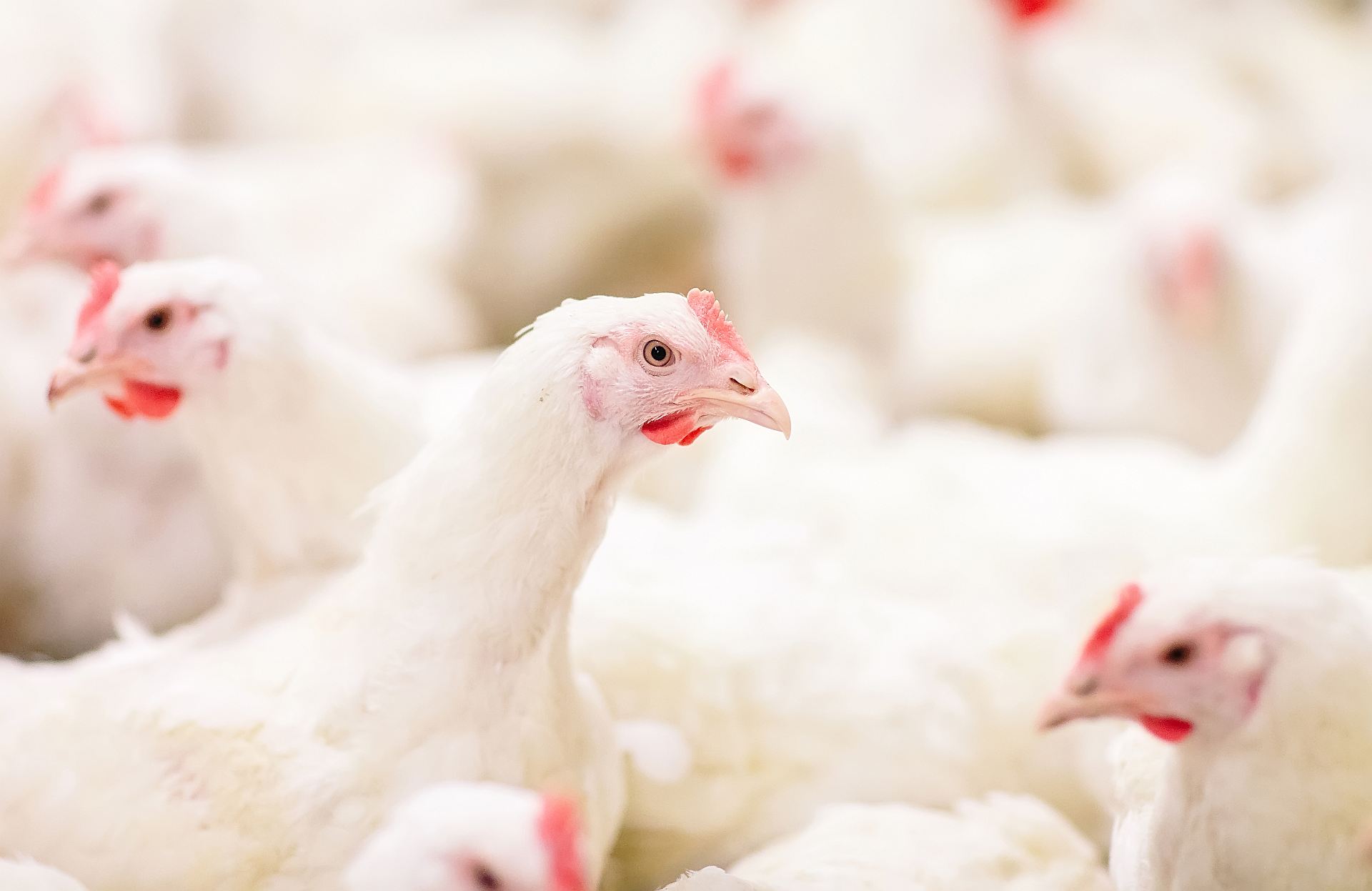
As feed represents 60-70 % of the total production costs, feed efficiency has a high impact on farm profitability – especially in times of high feed prices. Furthermore, for the meat industry, an optimal FCR is essential for competitiveness against other protein sources. Finally, for food economists, feed efficiency is connected to the optimal use of natural resources (Patience et al., 2015).
In this article, we explain the factors that influence feed efficiency and show options to support animals in optimally utilizing the feed – directly improving the profitability of your operation.
The FCR shows how efficiently animals utilize their diet for maintenance and net production. In the case of fattening animals, it is meat production; for dairy cows, it is milk, and for layers, it is egg mass (kg) or a specific egg quantity.
The feed conversion rate is the mathematical relation obtained by dividing the amount of feed the animal consumed by the production it provided. The FCR is an index for the degree of feed utilization and shows the amount of feed needed by the animal to produce one kg of meat or egg mass, or, e.g., 10 eggs.

When comparing the FCRs of different groups of animals (e.g., from different houses or farms), some considerations are important:
There are internal and external factors that influence feed efficiency. Internal factors originate in the animal and include genetics, age, body composition, and health status. In contrast, external factors include feed composition, processing, and quality, as well as the environment, welfare enrichment, and social aspects.
Different species have different body sizes and physiology and, therefore, vary in their growth and maintenance requirements, impacting their efficiency in converting the feed.
Table 1: FCRs of different species

Compared to terrestrial animals, for example, fish and other aquatic animals have a low FCR. Being poikilothermic (animals whose body temperature ranges widely), they don’t spend energy on maintaining their body temperature if the surrounding water is within their optimal range. As they are physically supported by water, they also need less energy to work against gravity. Furthermore, carnivorous fish are offered highly digestible, nutrient-dense feed, which lowers their requirements in quantity. Omnivorous fish, on the other hand, also consume feedstuffs not provided by the producer (e.g., algae and krill), which is not considered in the calculation. Broilers are the only farm animals achieving a similar FCR.
Sex determines gene expression related to the regulation of feed intake and nutrient utilization. Males have a better feed conversion and put on more lean meat than females and castrates, which grow slower and easier run to fat.
Young animals have a fast growth rate and are offered nutritionally dense feed; hence, their FCR is lower. When the animal grows and gains weight, its energy requirement for maintenance increases and its growth rate and the feed nutrient density diminish.
Table 2: FCR during different life phases of pigs (based on Adam and Bütfering, 2009)
| Age / weight / phase | FCR | |
| Piglet | 0 – 2 weeks | 1.1 – 1.2 |
| 3 – 6 weeks | 1.6 – 1.8 | |
| Grower-finisher | 30 – 120 kg | ~ 2.6 |
| End of fattening | 4 – 5 |
Health decisively impacts feed conversion. An animal that is challenged by pathogens reduces its feed intake and, thus, decreases growth. Additionally, the body needs energy for the immune defense, the replacement of damaged or lost tissue, and heat production, in case of fever. As many immune components are rich in protein, this is the first nutrient to become limited.
An imbalance in the gut microbiome also impacts feed conversion: pathogenic microorganisms damage tissues, impair nutrient digestion and absorption, and their metabolic products are harmful. Furthermore, pathogens consume nutrients intended for the host and continue to proliferate at its expense.
The environment influences the way the animals spend their maintenance energy. According to Patience (2012), when a 70 kg pig is offered feed ad libitum, 34 % of the daily energy is used for maintenance. For each °C below the thermoneutral zone, an additional 1.5% of feed is needed for maintenance. In heat stress, each °C above the optimum range decreases feed intake by 2%. Therefore, the feed needs to be denser to fulfill the requirement, or the animal will lose weight. Social stress also influences animal performance, especially chronic stress situations. Keeping the animals in their thermoneutral zone and mitigating the impact of stressors means more energy can go towards performance.
The feed is the source of nutrients animals convert into production. So, it’s natural that its quality and composition, and the availability of nutrients affect feed efficiency.
Higher energy content in the diet and better protein digestibility improve FCR. Saldaña et al. (2015) assert that increasing the energy content of a diet led to a linear decrease of the average daily feed intake but improved FCR quadratically. The energy intake by itself remained equal. However, these diet improvements also increase costs, and a cost-benefit analysis should be conducted.
Feed processing can improve nutrient utilization. Particle size, moisture content, and whether the feed is offered as pellets or mash influence feed efficiency. Reducing the particle size leads to a higher contact surface for digestive enzymes and higher digestibility. Chewning et al. (2012) tested the effect of particle size and feed form on FCR in broilers. They found that pellet diets enable better FCRs than mash diets – one reason is the lower feed waste, another one the smaller feed particle size in the pelleted feed. Comparing the different tested mash diets, the birds receiving feed with a particle size of 300 µm performed better than the birds getting a diet with 600 µm particles.
Richert and DeRouchey (2015) show that pigs’ feed efficiency improved by 1.3 % for every 100 µm when the particle size was reduced from 1000 µm to 400 µm , as the contact surface for the digestible enzymes increased. In weaning piglets of 28-42 days, the increase of particle size from 394 µm to 695 µm worsened FCR from 1.213 to 1.245 (Almeida et al., 2020). There is a flipside to smaller particle size as well, however: high quantities of fines in the diet can lead to stomach ulceration in pigs (Vukmirović et al., 2021).
The carbohydrates in feedstuffs such as wheat, rye, and barley are not only energy suppliers, and if not managed well, the inclusion of these raw materials can deteriorate feed conversion. Vegetable structural substances such as cellulose, hemicellulose, or lignin (e.g., in bran), are difficult or even impossible to utilize as they lack the necessary enzymes.
Figure 1: Contents of arabinoxylan and ß-glucan in grain (according to Bach Knudsen, 1997)

Additionally, water-soluble NSPs (e.g., pectins, but also ß-glucans and pentosans) have a high water absorption capacity. These gel-forming properties increase the viscosity of the digesta. High viscosity reduces the passage rate and makes it more difficult for digestive enzymes and bile acids to come into contact with the feed components. Also, nutrients’ contact with the resorptive surface is reduced.
Another disadvantage of NSPs is their “cage effect.” The water-insoluble NSPs cellulose and hemicellulose trap nutrients such as proteins and digestible carbohydrates. Consequently, again, digestive enzymes cannot reach them, and they are not available to the organism.
Molds reduce the nutrient and energy content of the feed and negatively impact feed efficiency. They are dependent on active water in the feed and feed ingredients. Compared to bacteria, which need about 0.9-0.97 Aw (active water), most molds require only 0.86 Aw.
Table 3: Comparison of 28-day-old chicks performance fed not-infested and molded corn
| Weight gain (g) | FCR | |
| Non-infested corn | 767 a | 1.79 a |
| Molded corn | 713 b | 1.96 b |
Besides spoiling raw materials and feed and reducing their nutritional value, molds also produce mycotoxins which negatively impact animal health, including gut health. They damage the intestinal villi and tight junctions, reducing the surface for nutrient absorption. In a trial with broiler chickens, Kolawole et al. (2020) showed a strong positive correlation between the FCR and the exposure to different mycotoxins. The increase in levels of toxin mixtures resulted in poor FCR. Williams and Blaney (1994) found similar results with growing pigs. The animals received diets containing 50 % and 75 % of corn with 11.5 mg nivalenol and 3 mg zearalenone per kg. The inclusion of contaminated corn led to a deterioration of feed efficiency from 2.45 (control) to 3.49 and 3.23.
DDGS (distiller’s dried grains with solubles), by-products of corn distillation processes, are often used as animal feed, especially for pigs. The starch content is depleted in the distillation process and thus removed. The fat, however, is concentrated, and DDGS reach a similar energy content as corn.
Pigs also receive fats from different sources (e.g., soybean or corn oil, restaurant grease, animal-vegetable blends), especially in summer. Due to heat, the animals eat less, so increasing energy density in the feed is a possibility to maintain the energy intake. The high fat content, however, makes these feeds susceptible to oxidation at high temperatures.
The oxidation of feedstuffs manifests in the rancidity of fats, destruction of the fat-soluble vitamins A, D, and E, carotenoids (pigments), and amino acids, leading to a lower nutritional value of the feed.
The feed industry offers many solutions to improve the FCR for different species. They usually target the animal’s digestive health or maintain/enhance feed quality, including increasing nutrient availability.
Producers can improve gut health by preventing the overgrowth of harmful microorganisms and by mitigating the effects of harmful substances. For this purpose, two kinds of feed additives are particularly suitable: phytomolecules and products mitigating the impact of toxins and mycotoxins.
By preventing the proliferation of pathogens, phytomolecules help the animal in three ways:
Only a healthy gut can optimally digest feed and absorb nutrients.
In trials testing the phytogenic Activo product range, supplemented animals showed the following FCR improvements compared to non-supplemented control groups (Figure 2). Note that phytomolecules also have a digestive effect that contributes to the FCR improvements:
Figure 2: FCR improvements for animals receiving Activo

Both mycotoxins and bacterial toxins negatively impact gut health. Mycotoxins are ingested with the feed; bacterial toxins appear when certain bacteria proliferate in the gut, e.g., gram-negative bacteria releasing LPS or Clostridium perfringens producing NetB and Alpha-toxin.
Products that mitigate the harmful effects of toxins help to protect gut health and maintain an optimal feed efficiency, as shown with a trial conducted with Mastersorb Gold:
Table 4: Trial design, the impact of Mastersorb Gold on broilers challenged with zearalenone and DON-contaminated feed
| Control | Mastersorb Gold | Challenge | Challenge + Mastersorb Gold | |
| Challenge | — | — | 300ppb zearalenone and 6000ppb DON | 300ppb zearalenone and 6000ppb DON |
| Additive | — | MSG (2 kg / MT of feed) | — | MSG (1 kg / MT of feed) |
Figure 3: Average FCR for broilers, with or without zearalenone and DON challenge, with or without Mastersorb Gold supplementation
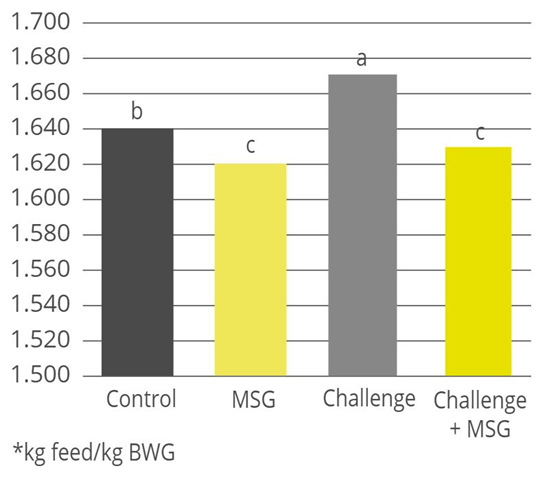
Maximum use of the nutrients contained in the feed can be obtained with the help of feed additives that promote digestion. Targeting the animal, selected phytomolecules are used for their digestive properties. Focusing on the feed, specific enzymes can unlock nutrients and thus improve feed efficiency.
Phytomolecules promote optimal digestion and absorption of nutrients by stimulating the secretion of digestive juices, such as saliva or bile, enhancing enzyme activity, and favoring good GIT motility (Platel and Srinivasan, 2004). FCR improvements thanks to the use of a phytomolecules-based product (Activo) are shown in figure 2.
Enzymes can degrade arabinoxylans, for example. Arabinoxylans are the most common NSP fraction in all cereals – and are undigestible for monogastric animals. Enzymes can make these substances available for animals, allowing for complete nutrient utilization. Additionally, nutrients trapped due to the cage effect are released, altogether increasing the energy content of the diet and improving FCR.
The quality of feed can deteriorate, for instance, when nutrients oxidize, or mold infestation occurs. Oxidation by-products promote oxidative stress in the intestine and may lead to tissue damage. Molds, in turn, take advantage of the nutrients contained in the feed and produce mycotoxins. Both cases illustrate the importance of preventing feed quality issues. Feed additives such as antioxidants and mold inhibitors mitigate these risks.
Antioxidants scavenge free radicals and protect the feed from spoilage. In animals, they mitigate the adverse effects of oxidative stress. Antioxidants in pig nutrition can stabilize DDGS and other fatty ingredients in the feed, maintaining nutrient integrity and availability. Figure 4 shows the FCR improvement that a producer in the US obtained when using the antioxidant product Santoquin in pork finisher diets containing 30% DDGS.
Figure 4: FCR improvement in pigs receiving Santoquin (trial with a Midwest pork producer)
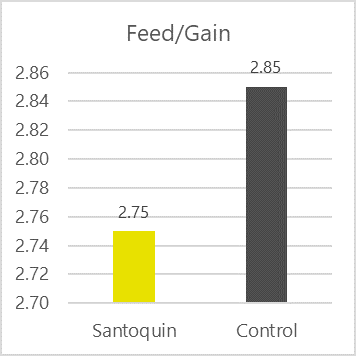
In DDGS-free diets, which are more common in poultry production, antioxidants also help optimize FCR, as shown by the results of a comprehensive broiler field study in 2015 (figure 5).
Figure 5: FCR in broilers receiving Santoquin, compared to a non-supplemented control group
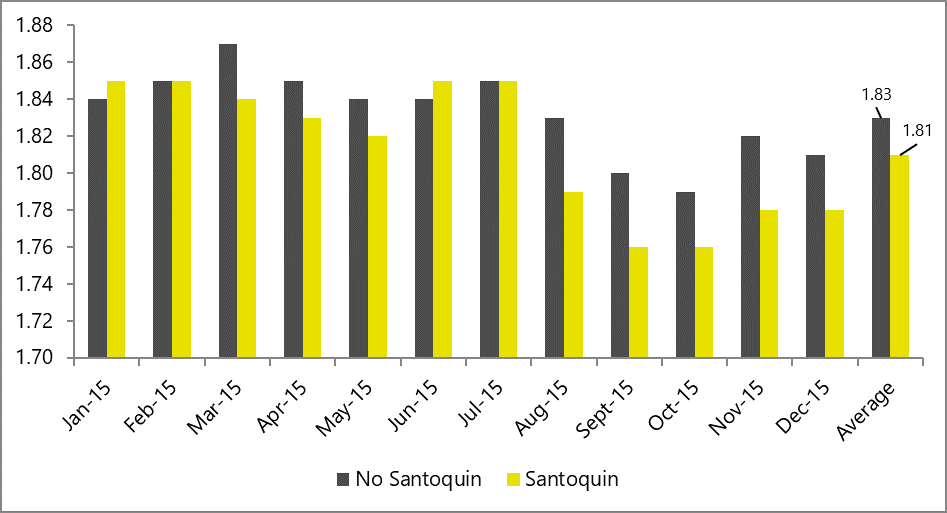
To round off the topic of feed quality preservation, one should consider mold inhibitors, which also play an essential role. Used at the feed mill, these products blend two types of ingredients with their different modes of action: surfactants and organic acids. Surfactants bind active water so that the moisture of the feed persists, but fungi cannot survive. Organic acids, on the other hand, have anti-fungal properties, directly acting against molds. Both actions together prevent the reduction of energy in the feed, keeping feed efficiency at optimal levels.
The improvement of feed efficiency ranks as one of the most, if not the most, critical measures to cope with rising feed costs. By achieving optimal nutrient utilization, producers can make the most out of the available raw materials.
The feed industry offers diverse solutions to support animal producers in optimizing feed efficiency. Improving gut health, mitigating the negative impact of harmful substances, and maintaining feed quality are crucial steps to achieving the best possible FCR and, hence, cost-effective animal production.
Adam, F., and L. Bütfering. “Wann Müssen Meine Schweine an Den Haken?” top agrar. top agrar online, October 1, 2009. https://www.topagrar.com/schwein/aus-dem-heft/wann-muessen-meineschweine-an-den-haken-9685161.html.
Almeida, Leopoldo Malcorra, Vitor Augusto Zavelinski, Katiucia Cristine Sonálio, Kariny Fonseca da Silva, Keysuke Muramatsu, and Alex Maiorka. “Effect of Feed Particle Size in Pelleted Diets on Growth Performance and Digestibility of Weaning Piglets.” Livestock Science 244 (2021). https://doi.org/10.1016/j.livsci.2020.104364.
Chewning, C.G., C.R. Stark, and J. Brake. “Effects of Particle Size and Feed Form on Broiler Performance.” Journal of Applied Poultry Research 21, no. 4 (2012): 830–37. https://doi.org/10.3382/japr.2012-00553.
Gaines, A. M., B. A. Peerson, and O. F. Mendoza. “Herd Management Factors That Influence Whole Feed Efficiency.” Essay. In Feed Efficiency in Swine, edited by J. Patience, 15–39. Wageningen Academic, 2012.
Kolawole, Oluwatobi, Abigail Graham, Caroline Donaldson, Bronagh Owens, Wilfred A. Abia, Julie Meneely, Michael J. Alcorn, Lisa Connolly, and Christopher T. Elliott. “Low Doses of Mycotoxin Mixtures below EU Regulatory Limits Can Negatively Affect the Performance of Broiler Chickens: A Longitudinal Study.” Toxins 12, no. 7 (2020): 433. https://doi.org/10.3390/toxins12070433.
Patience, J. F. “The Influence of Dietary Energy on Feed Efficiency in Grow-Finish Swine.” Essay. In In Feed Efficiency in Swine, edited by J. Patience, 15–39. Wageningen Academic, 2012.
Patience, John F., Mariana C. Rossoni-Serão, and Néstor A. Gutiérrez. “A Review of Feed Efficiency in Swine: Biology and Application.” Journal of Animal Science and Biotechnology 6, no. 1 (2015). https://doi.org/10.1186/s40104-015-0031-2.
Platel, K., and K. Srinivasan. “Digestive Stimulant Action of Spices: A Myth or Reality?” Indian J Med Res, pp 167-179 119 (May 2004): 167–79. http://www.ncbi.nlm.nih.gov/pubmed/15218978
Richert, B. T., and J. M. DeRouchey. “Swine Feed Processing and Manufacturing.” Pork Information Gateway, September 14, 2015. https://porkgateway.org/resource/swine-feed-processing-and-manufacturing/.
Saldaña, B., P. Guzmán, L. Cámara, J. García, and G.G. Mateos. “Feed Form and Energy Concentration of the Diet Affect Growth Performance and Digestive Tract Traits of Brown-Egg Laying Pullets from Hatching to 17 Weeks of Age.” Poultry Science 94, no. 8 (2015): 1879–93. https://doi.org/10.3382/ps/pev145.
Vukmirović, Đuro, Radmilo Čolović, Slađana Rakita, Tea Brlek, Olivera Đuragić, and David Solà-Oriol. “Importance of Feed Structure (Particle Size) and Feed Form (Mash vs. Pellets) in Pig Nutrition – A Review.” Animal Feed Science and Technology 233 (2017): 133–44. https://doi.org/10.1016/j.anifeedsci.2017.06.016.
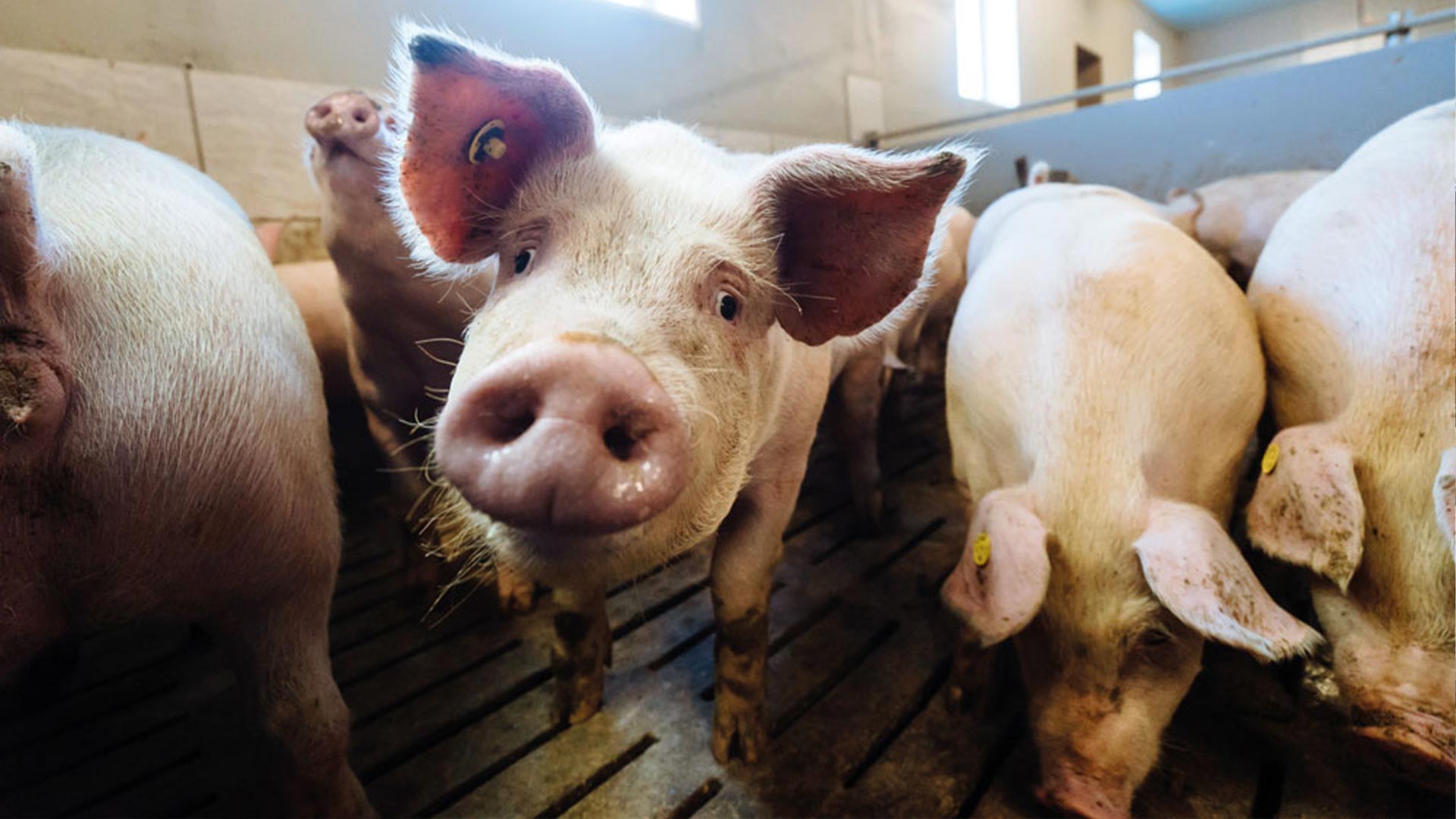
by Merideth Parke, Regional Technical Manager, EW Nutrition
To contain and reverse antimicrobial resistance, consumers and government regulators expect changes in pork production with the clear goal to reduce antibiotic use. For healthy, profitable pig production with simultaneous antibiotic reduction, a holistic strategy is required: refocusing human attitudes and habits, optimal pig health and welfare, and applying potential antibiotic alternatives.
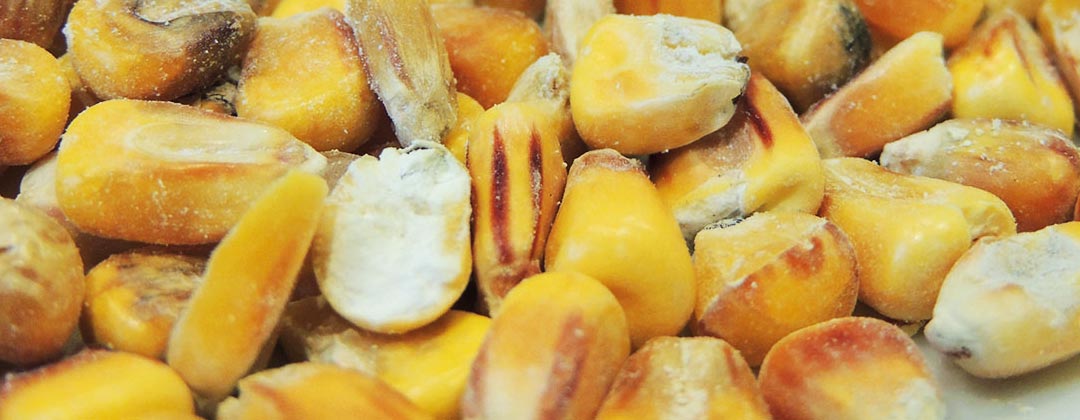
Intensive pig production has stress points associated with essential husbandry procedures such as weaning, health interventions, and dietary modifications. Stress is widely accepted to have a negative impact on immune system effectiveness, enhancing opportunities for pathogenic bacteria to invade at a local or systemic level. The gastrointestinal and respiratory systems are highly susceptible to developing disease as a result of these combined factors. Interventions such as antibiotics are commonly implemented to reduce the impact of pathogens and manage pig health. Processes that minimize the number of pathogens in the environment are the foundation for a successful antibiotic reduction plan. The challenge is to smartly combine strategies to keep the gastrointestinal and respiratory tract intact and robust.
Phytomolecules, the specific active defense compounds found in plants, have been identified as capable of enhancing pig health through antimicrobial (Cimanga et al., 2002, Franz et al., 2010), antioxidative (Katalinic et al., 2006, Damjanovic-Vratnica et al., 2007, Lee et al., 2011), digestion-stimulating and immune-supportive functions. As many thousands of phytomolecules exist, laboratory research has focused on identifying those with the capability of microbial management, facilitating the end goal of reducing the reliance on antibiotics for pig health and welfare and the production of safe pork (Zhai et al., 2018).
The gastrointestinal tract benefits from applying phytomolecules such as capsaicin, carvacrol, and cinnamaldehyde, as they:
Pigs most susceptible and in need of phytomolecule gastrointestinal supportive actions are piglets at weaning and pigs of all ages undergoing stress, pathogen challenges, and/or dietary changes.
Porcine respiratory disease is a complex multifactorial disorder. It frequently requires antibiotics to manage infection pressure and clinical disease to maintain pig health, welfare, and production performance. Causal pathogens may be transmitted by direct contact between pigs in saliva (Murase et al., 2018) or bioaerosols (LeBel et al., 2019), via the nasal or oral cavities (inhalation directly into the airways and lungs), or via an unhealthy gut. Phytomolecules such as carvacrol and cinnamaldehyde have antimicrobial properties. Hence, they may help contain respiratory pathogens in their natural habitat (the upper respiratory tract) or during transit through the oronasal cavity and gastrointestinal tract (Swildens et al., 2004, Lee et al., 2001).
In addition to supporting the gastrointestinal and respiratory systems, phytomolecules such as menthol and 1,8-cineole have been shown to enhance the physical and adaptive immune systems in multiple species (Brown et al., 2017, Barbour et al., 2013). When applied via drinking water, adherence to the oronasal mucosa facilitates the inhalation of the active phytomolecule compounds into the respiratory tract. There, they act as mucolytics, muscle relaxants, and enhancers of the mucociliary clearance mechanism (Başer and Buchbauer, 2020). Phytomolecules have also been documented to positively influence the adaptive immune system, promoting both humoral and cell-mediated immune responses (Awaad et al., 2010, Gopi et al., 2014, Serafino et al., 2008).
Antibiotic reduction programs positively enact social responsibility by reducing the risk to farmworkers of exposure to antimicrobial-resistant bacteria. They also help maintain or increase efficiency in safe pork production – pork with minimal risk of antibiotic residues.
Implementation of a successful health program with reduced antibiotic use will require:

A combination of in vitro and in vivo studies provides evidence that specific phytomolecules can support both enteric and respiratory systems through biome stabilisation and pathogen management (Bajabai et al., 2020). Antimicrobial activity of thymol, carvacrol, and cinnamaldehyde has been reported against respiratory pathogens including S. suis, A. pleuropneumoniae, and H. parasuis (LeBel et al., 2019); multi-drug resistant and ESBL bacteria (Bozin et al., 2006); enteric pathogens including E. coli, Salmonella enteritidis, Salmonella cholerasuis, and Salmonella typhimurium (Penalver et al., 2005); Clostridium spp., E. coli spp., Brachyspira hyodysenteriae (Vande Maelle et al., 2015); and Lawsonia intracellularis (Draskovic et al., 2018). These results have shown phytomolecules to be effective antimicrobial alternatives for incorporation into holistic pig health programs.
Additionally, the inclusion of phytomolecules into pig production systems also enhances production performance by reducing the negative impact of stress on the pig and increasing the positive effects on gut health and nutrient utilization (Franz et al., 2010). Phytomolecules that directly impact digestive actions include capsaicin, which optimizes the production of digestive enzymes and increases serotonin for gut contraction maintenance and improved digesta mixing (Zhai et al., 2018). Cineol’s antioxidative activities provide support during times of stress (Cimanga et al., 2002).
The pig industry searches for alternatives to therapeutic, prophylactic, and growth-promoting antibiotic applications to keep available antibiotics effective for longer – and to address the social responsibility of mitigating AMR. This search for ways to produce safe pork has made it clear that only a combination of management and antibiotic alternatives can achieve these aligned goals.
Biosecurity, hygiene, stress reduction, and husbandry and nutritional advances form the foundation for the strategic application of specific phytomolecules (Zeng et al. 2016). Supporting pig production and health, this complete holistic solution (EIP-AGRI) moves the pig industry into a future where antibiotic reduction or removal, with equivalent or increased production of safe pork, becomes a reality.
Awaard M, Abdel-Alim G, Sayed K, Kawkab, Ahmed1 A, Nada A , Metwalli A, Alkhalaf A. “Immunostimulant effects of essential oils of peppermint and eucalyptus in chickens”. Pakistan Veterinary Journal (2010). 2:61-66. http://www.pvj.com.pk/
Bajagai YS, Alsemgeest J, Moore RJ, Van TTH, Stanley D. “Phytogenic products, used as alternatives to antibiotic growth promoters, modify the intestinal microbiota derived from a range of production systems: an in vitro model”. Applied Microbiology and Biotechnology (2020). 104:10631-10640. https://doi.org/10.1007/s00253-020-10998-x
Barbour EK, Shaib H, Azhar E, Kumosani T, Iyer A, Harakey S, Damanhouri G, Chaudary A, Bragg RR. “Modulation by essential oil of vaccine response and production improvement in chicken challenged with velogenic Newcastle disease virus”. Journal of Applied Microbiology (2013). 115, 1278-1286. https://doi:10.1111/jam.12334
Biljana Damjanovic-Vratnica, Tatjana Dakov, Danijela Sukovic, Jovanka Damjanovic. “Antimicrobial effect of essential oil isolated from Eucalyptus globulus Labill” (2011). Czech Journal of Food Science 27(3):277-284. https://www.agriculturejournals.cz/publicFiles/39925.pdf
Bozin B, Mimica-Dukic N, Smin N, Anackov G. “Characterization of the volatile composition of essential oils of some Lamiaceae spices and the antimicrobial and antioxidant activities of the entire oils” Journal of Agriculture and Food Chemicals (2006). 54:1822-1828 https://pubs.acs.org/doi/10.1021/jf051922u
Brown SK, Garver WS, Orlando RA. “1,8-cineole: An Underappreciated Anti-inflammatory Therpeutic” Journal of Biomolecular Research &Therapeutics (2017). 6:1 1-6 https://doi: 10.4172/2167-7956.1000154
Cimanga K., Kambu K., Tona L., Apers S., De Bruyne T., Hermans N., Totte J., Pieters L., Vlietinck A.J. “Correlation between chemical composition and antibacterial activity of essential oils of some aromatic medicinal plants growing in the Democratic Republic of Congo”. Journal of Ethnopharmacology (2002) 79: 213–220. https://doi.org/10.1016/s0378-8741(01)00384-1
Draskovic V, Bosnjak-Neumuller J, Vasiljevic M, Petrujkic B, Aleksic N, Kukolj V, Stanimirovic Z. “Influence of phytogenic feed additive on Lawsonia intracellularis infection in pigs” Preventative Veterinary Medicine (2018). 151: 46-51 https://doi.org/10.1016/j.prevetmed.2018.01.002
European Innovation Partnership Agricultural Productivity and Sustainability (EIP-AGRI). https://ec.europa.eu/eip/agriculture/en/european-innovation-partnership-agricultural
Franz C., Baser KHC, Windisch W. “Essential oils and aromatic plants in animal feeding-a European perspective. A review Flavour”. Flavour and Fragrance Journal (2010) 25:327-40. https://doi.org/10.1002/ffj.1967
Gopi M, Karthik K, Manjunathachar H, Tamilmahan P, Kesavan M, Dashprakash M, Balaraju B, Purushothaman M. “Essential oils as a feed additive in poultry nutrition”. Advances in Animal and Veterinary Sciences (2014) 1:17. https://doi.10.14737/journal.aavs/2014.2.1.1.7
Başer, Kemal Hüsnü Can, and Gerhard Buchbauer. Handbook of Essential Oils Science, Technology, and Applications. Boca Raton: CRC Press, 2020.
Hengziao Zhai, Hong Liu, Shikui Wang, Jinlong Wu, Anna-Maria Kluenter. “Potential of essential oils for poultry and pigs.” Animal Nutrition 4 (2018): 179-186. https://doi.org/10.1016/j.aninu.2018.01.005
Katalinic V., Milos M., Kulisic T., Jukic M. “Screening of 70 medicinal plant extracts for antioxidant capacity and total phenols”. Food Chemistry (2006) 94(4):550-557. https://doi.org/10.1016/j.foodchem.2004.12.004
LeBel G., Vaillancourt K., Bercier P., Grenier D. “Antibacterial activity against porcine respiratory bacterial pathogens and in vitro biocompatibility of essential oils”. Archives of Microbiology (2019) 201:833-840; https://doi.org/10.1007/s00203-019-01655-7
Lee KG, Shibamoto T. “Antioxidant activities of volatile components isolated from Eucalyptus species”. Journal of the Science of Food and Agriculture (2001). 81:1573-1597. https://doi.org/10.1002/jsfa.980
Liu SD, Song MH, Yun W, Lee JH, Lee CH, Kwak WG Han NS, Kim HB, Cho JH. “Effects of oral administration of different dosages of carvacrol essential oils on intestinal barrier function in broilers” Journal of Animal Physiology and Animal Production (2018) https://doi.org/10.1111/jpn.12944
Murase K, Watanabe T, Arai S, Kim H, Tohya M, Ishida-Kuroki K, Vo T, Nguyen T, Nakagawa I, Osawa R, Nguyen N, Sekizaki T. “Characterization of pig saliva as the major natural habitat of Streptococcus suis by analyzing oral, fecal, vaginal, and environmental microbiota”. PLoS ONE (2019). 14(4). https://doi.org/10.1371/journal.pone.0215983
Nethmap MARAN report 2018. https://www.wur.nl/upload_mm/7/b/0/5e568649-c674-420e-a2ca-acc8ca56f016_Maran%202018.pdf
Penalver P, Huerta B, Borge C, Astorga R, Romero R, Perea A. “Antimicrobial activity of 5 essential oils against origin strains of the Enterobacteriaceae family”. Acta Pathologica Microbiologica, et Immunologica Scandinavica (2005) 113:1-6. AromaticScience, LLC Antimicrobial activity of five essential oils against origin strains of the Enterobacteriaceae family.
Serafino A, Vallebona PS, Adnreola F, Zonfrillo M, Mercuri L, Federici M, Rasi G, Garaci E, Pierimarchi P. “Stimulatory effect of Eucalyptus essential oil on innate cell-mediated immune response” BioMed Central (2008). 9:17 https//:doi:10.1186/1471-2172-9-17
Swildens B, Stockhofe-Zurwieden N, van der Meulen J, Wisselink HJ, Nielen M. “Intestinal translocation of Streptococcus suis type 2 EF+ in pigs”. Veterinary Microbiology (2004) 103:29-33. https://doi: 10.1016/j.vetmic.2004.06.010
Vande Maele L, Heyndrickx M, Maes D, De Pauw N, Mahu M, Verlinden M, Haesbrouck F, Martel A, Pasmans F, Boyen F. “In vitro susceptibility of Brachyspira hyodysenteriae to organic acids and essential oil components”. Journal of Veterinary Medical Science (2016). 78(2):325-328. https://doi.org/10/1292/jvms.15-0341
Zeng Z, Zhang S, Wang H, Piao X. “Essential oil and aromatic plants as feed additives in non-ruminant nutrition: a review”. Journal of Animal Science and Biotechnology (2015) 6:7. https://doi.org?10/1186/s40104-015-004-5
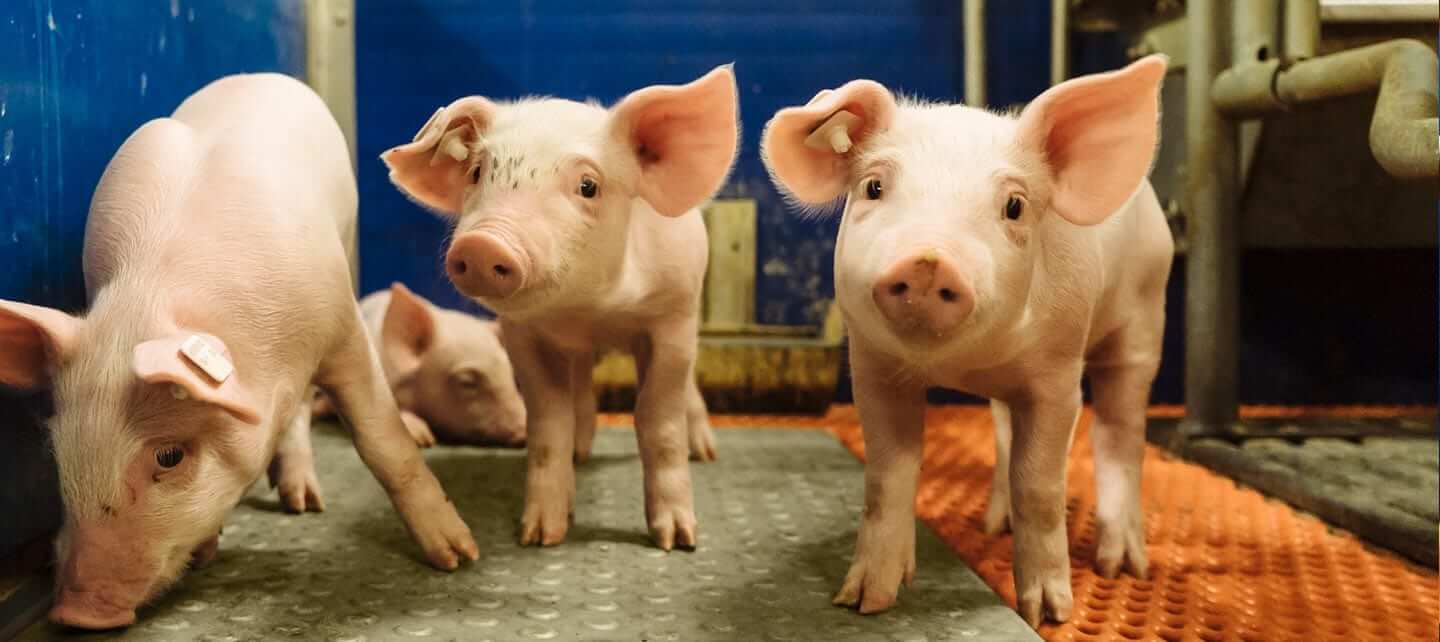

In contrast to humans, piglets do not receive any maternal immunoglobulins via the placenta. It is therefore of vital importance for these young animals to receive maternal antibodies via the colostrum as soon as possible after birth. Otherwise, they are more vulnerable to illnesses in their early stages of life.
In this article, we look in-depth at how the immune system works and which role antibodies play in it. We then consider why egg proteins might potentially be a powerful tool for supporting young animals immunologically, allowing producers to maintain young animals’ health and to promote their performance.
The immune system aims to prevent pathogens such as viruses, bacteria, and fungi from entering the body or to eliminate them when they have already entered. Furthermore, it seeks to prepare the body for quicker reactions, in case of subsequent infections, by building an immunological memory. Generally, in case of an attack by pathogens, there are three barriers against the “enemy” (Figure 1).
Figure 1: The three barriers of the immune response
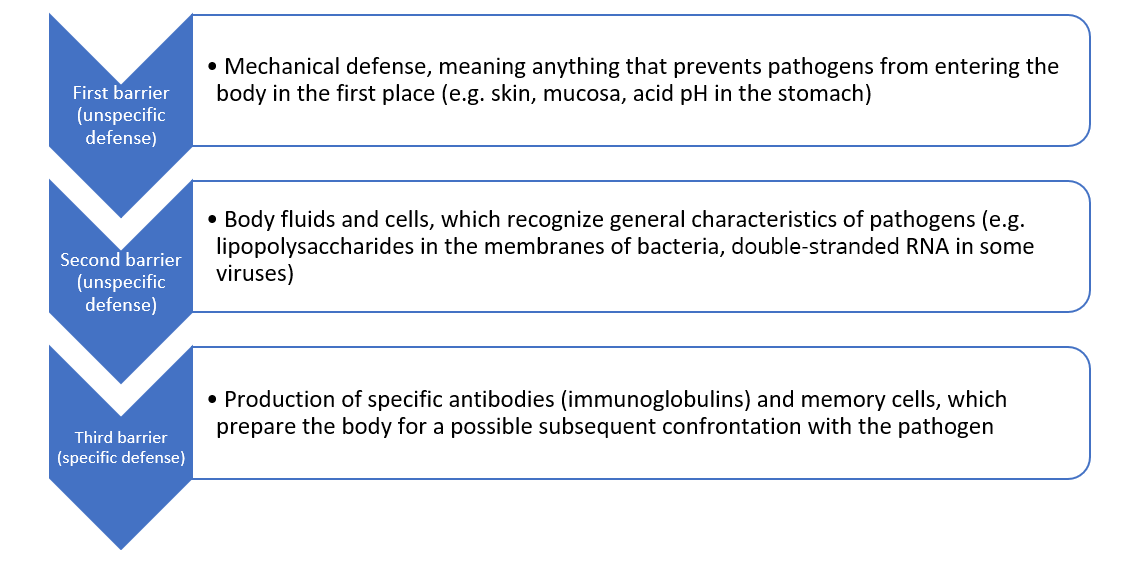
First barrier: the immediate, physical defense upon contact with pathogens
The animal body has several anatomical features that prevent pathogens from entering in the first place, such as cilia and mucus. Skin, intestines and nose lining are colonized by a community of beneficial micro-organisms that form a physical barrier against pathogens. Other barriers include the urinary system, the acid pH of the stomach, as well as tears and saliva, which contain antibacterial lysozymes.
Second barrier: the unspecific, native defense that does most of the work
If the mechanical mechanisms of defense were not successful, the unspecific, innate immune defense enters into play (Murphy and Weaver, 2018, 47ff.). At this stage, the body needs to differentiate between “known” and “alien” agents, and between “potentially harmful” and “harmless” ones.
To identify alien, potentially harmful agents, the unspecific defense looks for so-called PAMPs (pathogen associated molecular patterns). These are general characteristics often displayed by pathogens, such as lipopolysaccharides in the bacterial membrane or double-stranded RNA in viruses. Everything that shows PAMPs is heavily targeted.
The unspecific defense can be further divided into the humoral and the cellular defense. The humoral defense consists of substances dissolved in the body fluids, such as enzymes, reactive oxygen compounds, signal molecules and a whole cascade of proteins. Some of these substances kill pathogens directly; others “mark” the pathogens and “call for” the help of leucocytes.
The cellular defense consists of different leucocytes, also known as white blood cells (because they do not contain any red hemoglobin). The main task of leucocytes is the defense of the body against pathogens, hence many leucocytes are capable of phagocytosis (the ingestion of other cells). To prevent phagocytes from accidentally ingesting the body’s own cells, these own cells are marked with the so-called major histocompatibility complex (MHC). This acts as a red flag, saying “I belong to the body!”.
The cellular defense consists of:
Figure 1: The three barriers of the immune response

The monocytes, as well as their macrophage and dendritic cell “offspring”, are the bridge to the next step, the specific defense. When these phagocytes digest pathogens, minuscule protein structures (antigens) of the pathogens remain. These antigens are unique to each pathogen. During a process called antigen presentation, the antigens are tied to the cell’s MHC and transported to the cell surface. This triggers the production of specific antibodies, the immune system’s third barrier.
Third barrier: the specific immune defense that creates antibodies and immunological memory
The specific (also called adaptive or acquired) immune response kicks in a few days after contact with specific pathogens and is mostly carried out by lymphocytes called T and B cells (Murphy and Weaver, 2018, 177ff.). They are active at the cellular and the humoral level, respectively.
T cells possess receptors on their surface through which they can recognize the antigens presented to them by phagocytes. What they do subsequently depends on the subtype of the T cell:
B cells also possess receptors through which they can recognize antigens. Once they spot an antigen (and T helper cells “confirm” that an immune response is required), they divide and mature into so-called plasma cells. Plasma cells, in turn, secrete plenty of antibodies (or immunoglobulins) into the bloodstream and the lymphatic system. Antibodies are protein structures that lock onto and neutralize antigens through different mechanisms.
The chemical reaction between antibodies and antigens is the body’s most powerful immune response through which it can protect itself from pathogens and their toxins. Antibody production continues for several days to remove the antigens, and antibodies usually remain in circulation for a few months.
Moreover, certain T and B cells memorize the first attack of a pathogen and turn into memory cells. The T memory cells CD4+CD8+, for instance, match the antigens from certain past, latent, and particularly persistent viral infections. This immunological memory, created by acquired immunity, can be thought of as a library of antibodies that the body adds to whenever it deals with a new pathogen or receives a vaccine. In case of a subsequent contact with the pathogen, the right antibody “model” already exists and mass production can start up very quickly.
Building one’s immunological memory takes time. A lot of new-born animals are in a vulnerable position: they have not had time yet to acquire immunity of their own, but they are also particularly fragile and susceptible to being attacked by commonly occurring pathogens such as corona and rotaviruses, E. coli and clostridia. The toxins that E. coli and clostridia, for instance, release, may cause diarrhea, edema, endotoxic shock, and even death.
To be protected during the first critical days of their lives, new-born animals thus need to receive a foundational stock of antibodies (passive immunity) from their mother. Humans receive maternal immunoglobulins via the placenta. Piglets, because a sow’s placenta is constructed differently, are dependent on receiving them through the colostrum after birth. If this is not the case – due to inadequate quantity or quality of the colostrum – they need to receive immune support in a different way.
Egg-yolk antibodies have been proposed as a powerful tool for supporting young animals during the critical period after birth. These special proteins support the colostrum supply and guarantee that every animal in the herd has some degree of protection. This protection mostly takes place in the gut. The IgY recognize and tie up pathogens and render them ineffective.
In 2009, research at the National Veterinary Research Institute in Pulawy, Poland, was conducted to probe this hypothesis. The objective of the trial was to evaluate whether an oral application of egg proteins would have a quantifiable, positive influence on the immune system of the piglets. Different immunological parameters were measured, including different types of leucocytes.
Trial design
The test consists of 6 litters with 67 piglets in total divided into two groups. The control group (n=32) received the prophylaxis customary on the farm; the trial group (n=35) additionally received a product based on egg powder (EP)[1], applied at the inclusion rate recommended by the producer. Blood samples were taken on days 0 (before application of the product), 7, 14, and 28. They were analyzed with respect to the percentages of different types of lymphocytes.
Trial results
For the group receiving egg powder, the number of leucocytes in peripheral blood was significantly elevated compared to the control group on the 7th day of life (table 1). The amounts of lymphocytes and monocytes – indicators for the specific immunological defense – were also significantly increased on day 7, whereas the total amount of granulocytes – indicator for the innate, unspecific immune defense – remained constant. Hence, already during the first days, the piglets supplied with EP disposed of a higher level of adaptive (specific) immune defense, compared to the animals in the control group. In addition, there was a significant increase in the number of CD4-positive (CD4+) and CD4-CD8-double positive (CD4+CD8+) T cells in the EP group, compared to the control animals, indicating an active stimulation of the immune system.
Except for CD4+CD8+ T cells (which remained elevated in the EP group), on day 14, the differences in cellular immune response were no longer significant. This is most probably the case because by that time the immune system of the control group had activated its own protective response. The EP product therefore supported the young animals precisely when it was necessary, during the critical first days of life.
Table 1: Hematological parameters measured in piglets after prophylactic application of an egg powder based product (EP1)
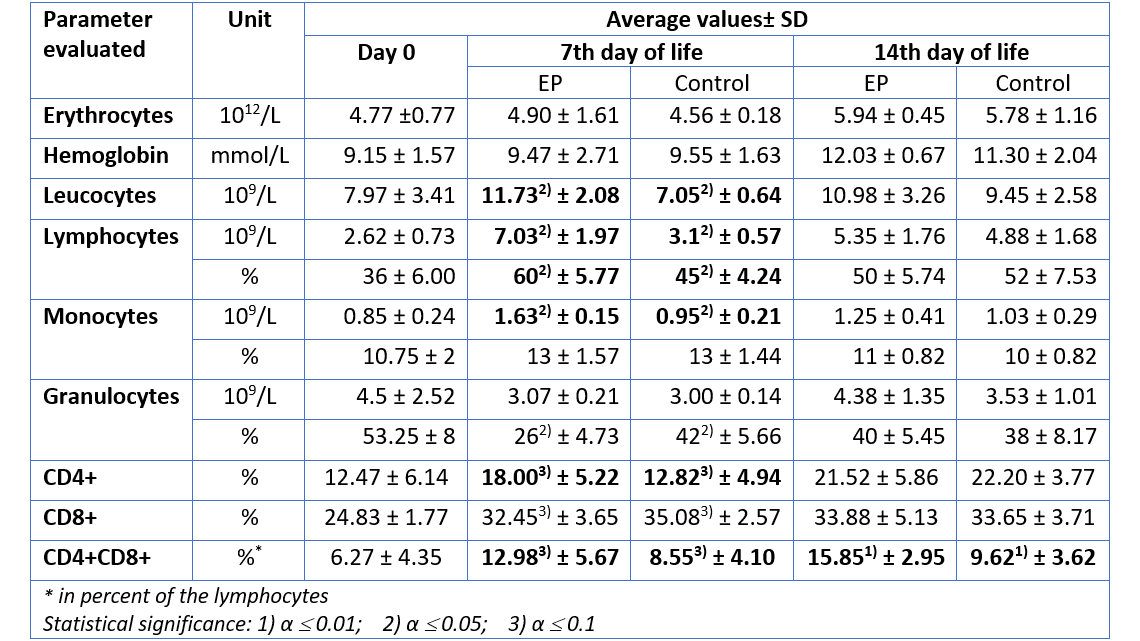
1Ig-PRO P (EW Nutrition)
The improvement of immune status, as indicated by the presence of the specific immune cells, was confirmed by the results for the incidence of diarrhea and mortality (table 2). The animals of the control group showed a nearly 1.5 times higher incidence of diarrhea and a 1.6 times higher rate of mortality. Another explanation of these results could be the mode of action of egg immunoglobulins: by neutralizing the pathogens directly in the gut, they prevent them from causing diarrhea in the first place.
Table 2: Incidence of diarrhea and mortality

In conclusion, this trial demonstrates that natural egg proteins effectively support the immune system of piglets during the critical period of the first days of life.
Thanks to the stimulation of the young animals’ specific immune defense and the direct neutralization of pathogens in the gut, the incidence of diarrhea – one of the main causes of losses during the first weeks of life – decreases. Hence, mind the immunity gap: providing piglets with a suitable egg powder based product sets them up for long-term health, growth, and performance.
By I. Heinzl and S. Regragui Mazili
Foley, J. A., and D. E. Otterby. “Availability, Storage, Treatment, Composition, and Feeding Value of Surplus Colostrum: A Review 1, 2.” Journal of Dairy Science 61, no. 8, 1033-1060. doi.org/10.3168/jds.S0022-0302(78)83686-8.
Heinzl, Inge, and Fellipe Barbosa. “Egg Antibody Technology for Nursery Pig Application.” Swineweb.com. June 24, 2019. Accessed July 17, 2019. http://www.swineweb.com/egg-antibody-technology-for-nursery-pig-application/.
Marquardt, Ronald R., L. Z. Jin, Jung-Woo Kim, Lin Fang, Andrew A. Frohlich, and Samuel K. Baidoo. “Passive Protective Effect of Egg-yolk Antibodies against Enterotoxigenic Escherichia Coli K88 Infection in Neonatal and Early-weaned Piglets.” FEMS Immunology and Medical Microbiology 23, no. 4 (1999): 283-288. https://doi.org/10.1111/j.1574-695X.1999.tb01249.x.
Murphy, Kenneth M., and Casey Weaver. 2018. Janeway Immunologie. 9th ed. Translated by Lothar Seidler. Berlin: Springer.
Nascimbeni, Michelina, Eui-Cheol Shin, Luis Chiriboga, David E. Kleiner, and Barbara Rehermann. “Peripheral CD4 CD8 T Cells Are Differentiated Effector Memory Cells with Antiviral Functions.” Blood 104, no. 2 (2004): 478-486. doi:10.1182/blood-2003-12-4395.
Yokoyama, Hideaki, Robert C. Peralta, Roger Diaz, Sadako Sendo, Yutaka Ikemori, and Yoshikatsu Kodama. “Passive Protective Effect of Chicken Egg Yolk Immunoglobulins.” Infection and Immunity 60, no. 3 (March 1992): 998-1007. https://iai.asm.org/content/iai/60/3/998.full.pdf.
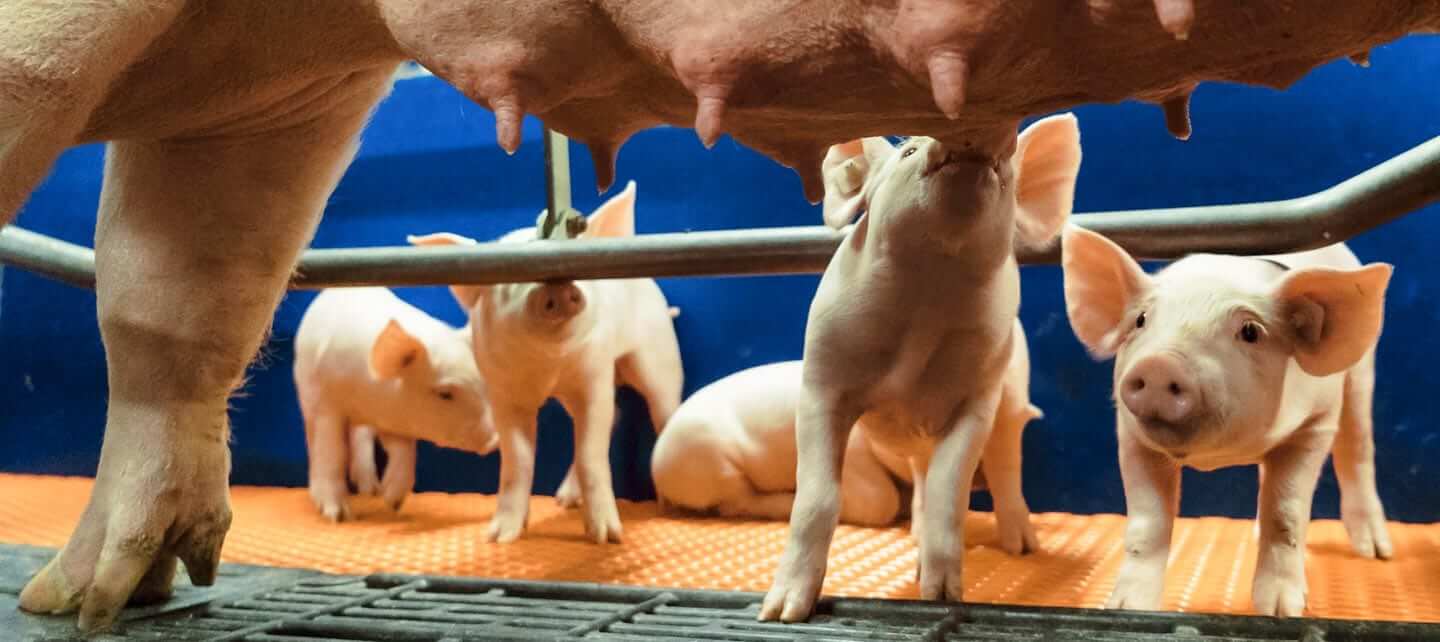

The most important parameters for a pig producer are the number of healthy pigs weaned/sow/year and their weaning weight. Due to improved genetics, it is possible today to find production systems that deliver more than 30 pigs weaned/sow/year. Strategies to increase sow productivity need to take into account the management, feeding, and health of both the piglets and the sows.
It is generally known that pigs are born physiologically immature. Their energy reserves are limited. They only possess 1-2 % fat, the main part of which is subcutaneous or structural fat protecting organs, joints and skin. Thus, the young pigs depend on the glucose of the glycogen deposits in the liver as main source of energy. This energy supply only meets their requirements for the first few hours.
Besides that, pigs cannot count on maternal antibodies. Unlike in humans, a sow’s placenta is not built to enable the transfer of these protective cells within the womb. At birth, the amount of protective cells in a pig’s intestine, the main site of pathogenic contamination, is therefore virtually zero. As they are born without any immune protection, new-born pigs rely on an early supply of antibodies from the maternal colostrum. During the first 24-36 hours after birth, antibodies are absorbed in the intestine and pass directly to the bloodstream. The intestinal barrier then closes. Importantly, the content of antibodies in the colostrum decreases with every hour after birth.
Given this difficult situation in the early stages of life, it is clear that the farrowing unit should be as comfortable as possible for the young animals:
Cleaning both the farrowing unit and also the sows/gilts before placing them is helpful. Producers, however, have to understand that a sow is continuously shedding pathogens through her feces and that her young come into contact with them. In fact, sow manure is the first source of contamination for new-born pigs.
There are several methods to decrease pathogens within the sow’s gut. Feeding them natural substances such as probiotics or phytomolecules (also known as secondary plant compounds) in order to improve gut health is one possibility: beneficial microbes such as lactobacilli or bifidobacteria compete with pathogens such as E. coli or clostridia for nutrients and prevent their proliferation. Phytomolecules such as carvacrol and cinnamaldehyde, on the other hand, were found to have antimicrobial properties.
Could feeding them natural egg proteins be another possibility?
Yokoyama et al. (1992 and 1997) already showed that natural egg proteins applied to piglets bind to pathogens within their intestinal tract. If they also bind pathogens in the sow’s gut – generating harmless complexes – this could be the key to reduce pathogenic pressure in the farrowing unit.
Method
To evaluate this possibility a trial was conducted in Japan. Two groups of eight sows were used. The sows of the control group received standard lactation feed. The trial group was also fed standard feed, but additionally received a supplement containing egg powder product (EPP) at a dosage of 5g/sow twice daily during the last ten days before and the first seven days after delivery. The feces of the sows were obtained by rectal stimulation (in order to rule out contamination from the environment) on day 10 before and day 7 after delivery. The amount of colony-forming units (CFU) of total E. coli, E. coli O141 and Clostridium perfringens was determined.
Results
The results are shown in figure 1. At the beginning of the trial, before the application of the EPP, both groups showed nearly the same level of the pathogens evaluated, with a slight disadvantage for the EPP group. After 17 days of using the EPP, the sows of the EPP group showed lower levels of pathogens in their excrements than the sows of the control group. A reduction in the colony-forming units of total Escherichia coli (from 107.12 to 106.3), Escherichia coli O141 (from 106.8 to 105.6) and of Clostridium perfringens (from 105.17 to 104.24) could be seen.
*The product used in this trial was Globimax® Sow, EW Nutrition.
It is important for pig producers to understand how they can combat adverse influences on their animals’ performance. The results of this trial showed that supplementing the standard sows’ diets with the EPP substantially reduced the amount of pathogenic colonies in sow’s manure. Reducing pathogenic pressure in the farrowing unit is central to reducing the incidence of diarrhea and pre-weaning mortality. Giving young pigs the best possible start in life sets them up for delivering the best possible performance – and more healthy and heavy pigs weaned/sow/year means a more profitable farm.
Figure 1: Amounts of total E. coli, O 141 E. coli and Clostridium perfringens in the feces of sows 10 days before delivery (before the first application of EPP) and 7 days after delivery (after the last application of EPP)
By Inge Heinzl and Fellipe Barbosa
Yokoyama, H., Peralta, R. C., Diaz, R., Sendo, S., Ikemori, Y. and Kodama, Y. (1992): Passive protective effect of chicken egg yolk immunoglobulins against experimental enterotoxigenic Escherichia coli infection in neonatal piglets. Infection and Immunity, March edition, 998-1007.
Yokoyama, H., Hashi, T., Umeda, K., Icatlo, F. C., Kuroki, M., Ikemori, Y. and Kodama, Y. (1997): Reduced intestinal colonization with F18-positive enterotoxigenic Escherichia coli in weaned pigs fed chicken egg antibody against the fimbriae. FEMS Immunology and Medical Microbiology (18), 153-161.
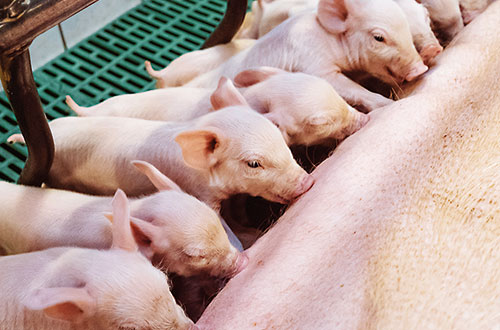
Piglets experience significant stress when they are weaned from the sow and change diet, making them susceptible to gastrointestinal disorders. Primarily during the first two weeks after weaning, they are likely to suffer from post-weaning diarrhea (PWD). PWD is a significant problem for pig producers worldwide: it leads to severe dehydration, stunted growth and mortality rates of up to 20-30%. Treatment and additional labor costs further squeeze farm profitability and necessitate unwanted antibiotic interventions.
Since the early 1990s zinc oxide (ZnO) has been used to control post-weaning diarrhea and promote growth in piglets, mainly at pharmacological dosages of 2500 to 3000ppm. Its mode of action is still not entirely understood; effects on immune or metabolic processes, altered microbiota, or post-absorptive metabolism are likely to play a role. What is clear is that the use of ZnO in European pig production has strongly increased since the EU banned the use of antibiotic growth promoters such as colistin in 2006 to curb the development of antimicrobial resistance.
Pigs depend on a continuous supply of zinc. Among other roles, this trace element constitutes a functional component of around 300 biochemical enzymes, making it pivotal to most metabolic processes, and by extension to optimal health, production and reproduction. Modern pig diets thus include zinc supplementation to meet the animals’ requirements. The European Food Safety Authority (EFSA) currently suggests that a total level of 150ppm of zinc in feed matches the animals’ physiological need for zinc. The EFSAs concerns are solely connected to the environmental concerns arising from pharmacological high dosages of ZnO.
These concerns are grave indeed: zinc is a heavy metal after all. Too much zinc is toxic for the animal, hence its physiology ensures that excessive zinc intake is excreted. The bioavailability and absorption of zinc from zinc oxide is particularly low. Therefore most of the zinc given to piglets in this way accumulates in their manure – which is widely used as an organic fertilizer for agricultural soils.
The continual application of manure gradually increases topsoil zinc concentrations; leaching and run-off then lead to contamination of groundwater, surface waters, and sediment. As zinc is non-volatile and non-degradable, it is only a matter of time before concentrations lead to ecotoxic effects, including food crops, aquatic life, and drinking water. Classic mitigation measures such as diluting the manure or keeping certain minimum distances between application areas and surface waters can only slow down the environmental accumulation of zinc, not prevent it.
In 2017, the European Medicines Agency (EMA) – the EU agency responsible for the scientific evaluation, supervision and safety monitoring of medicines, including veterinary medicinal products – conducted an overall risk-benefit analysis for ZnO. It concluded that the benefits of preventing diarrhea in pigs did not outweigh the significant environmental risks caused by zinc pollution. By June 2022 all EU member states will thus have to withdraw marketing authorizations for veterinary medicinal products containing zinc oxide that are administered orally to food-producing species.
In its decision, the EMA’s Committee for Medicinal Products for Veterinary Use also points out the risk that, due to co-resistance, the use of zinc oxide might promote the development of antimicrobial resistance. High doses of zinc supplementation have been shown to increase the proportion of multidrug-resistant E. coli and Salmonella, two of the most important pathogens in pig production.
What is more, studies show that excessive zinc can accumulate in the liver, the pancreas, and blood serum, and that it permanently reduces the lactobacilli population of the gut flora. With what consequences for performance in the fattening phase? Hence, there are plenty of reasons why getting rid of zinc oxide is a good thing and will ultimately result in even better, more sustainable pig production – but, of course, only if effective replacement strategies to control PWD and boost piglet performance are in place.
The search for ZnO alternatives takes us right back to the start, to the piglets’ challenged gastrointestinal tract. During their first three months of life, pigs’ gastrointestinal system undergoes a complex maturation process of its epithelial, immune, and enteric nervous systems. Only once all of these systems are fully developed is the gut capable of delivering its normal functions (digestion, nutrient absorption, immunity, etc.), while also providing an effective barrier against the pathogens, antigens, and toxins in the lumen.
Unlike in nature, where weaning occurs around the time when GIT functions have matured, weaning in commercial pig production takes place during this vulnerable developmental period. Post-weaning diarrhea is ultimately a consequence of intestinal dysbiosis, a state of imbalance in the intestinal microbiome which in turn is induced by the dietary, behavioral, and environmental stressors of the weaning phase (such as separation from the sow, vaccinations, transport, introduction of solid feed).
PWD control thus starts with managing these stressors, which includes ensuring sufficient colostrum intake, gradual feed changes, and meticulous nursery hygiene. Critically, the weaning diet needs to optimally support gut health. Intelligent feed additive solutions are able to
A synergistic combination of phytomolecules, medium-chain fatty acids, glycerides of butyric acid, and prebiotics achieves these objectives in a reliable and cost-effective manner. Thanks to their antimicrobial, anti-inflammatory, and digestive properties these selected ingredients effectively support piglets during this critical phase of their postnatal gut development, while also boosting their feed intake.
In the past decade, the European pig sector has successfully adapted to the 2006 ban on antibiotic growth promoters through significant improvements in management and feed practices. Cutting out zinc oxide is an ambitious challenge – but with the support of targeted, functional feed additives, producers will be able to set their piglets up for a strong, sustainable, zero ZnO health and growth performance.
*You can find this article in polish and italian.
Amezcua, Rocio, Robert M. Friendship, Catherine E. Dewey, Carlton Gyles, and John M. Fairbrother. “Presentation of postweaning Escherichia coli diarrhea in southern Ontario, prevalence of hemolytic E. coli serogroups involved, and their antimicrobial resistance patterns.” Canadian Journal of Veterinary Research 66, no. 2 (April 2002): 73-8. https://www.ncbi.nlm.nih.gov/pmc/articles/PMC226986/.
Bednorz, Carmen, Kathrin Oelgeschläger, Bianca Kinnemann, Susanne Hartmann, Konrad Neumann, Robert Pieper, Astrid Bethe, et al. “The Broader Context of Antibiotic Resistance: Zinc Feed Supplementation of Piglets Increases the Proportion of Multi-Resistant Escherichia Coli in Vivo.” International Journal of Medical Microbiology 303, no. 6-7 (2013): 396–403. https://doi.org/10.1016/j.ijmm.2013.06.004.
Brugger, Daniel, and Wilhelm M. Windisch. “Strategies and Challenges to Increase the Precision in Feeding Zinc to Monogastric Livestock.” Animal Nutrition 3, no. 2 (March 24, 2017): 103–8. https://doi.org/10.1016/j.aninu.2017.03.002.
Burrough, Eric R., Carson De Mille, and Nicholas K. Gabler. “Zinc Overload in Weaned Pigs: Tissue Accumulation, Pathology, and Growth Impacts.” Journal of Veterinary Diagnostic Investigation 31, no. 4 (June 6, 2019): 537–45. https://doi.org/10.1177/1040638719852144.
De Mille, Carson, Emma T. Helm, Eric R. Burrough, and Nicholas K. Gabler. “Zinc oxide does not alter ex vivo intestinal integrity or active nutrient transport in nursery pigs.” Paper presented at the Zero Zinc Summit, Copenhagen, Denmark, June 17-18, 2019. https://svineproduktion.dk/Services/-/media/3E0A1D2A4CAC409FAA6212B91DFEA537.ashx.
Moeser, Adam J., Calvin S. Pohl, and Mrigendra Rajput. “Weaning Stress and Gastrointestinal Barrier Development: Implications for Lifelong Gut Health in Pigs.” Animal Nutrition 3, no. 4 (December 2017): 313–21. https://doi.org/10.1016/j.aninu.2017.06.003.
Rhouma, Mohamed, Francis Beaudry, William Thériault, and Ann Letellier. “Colistin in Pig Production: Chemistry, Mechanism of Antibacterial Action, Microbial Resistance Emergence, and One Health Perspectives.” Frontiers in Microbiology 7 (November 11, 2016): Article 1789. https://doi.org/10.3389/fmicb.2016.01789.
Starke, Ingo C., Robert Pieper, Konrad Neumann, Jürgen Zentek, and Wilfried Vahjen. “The Impact of High Dietary Zinc Oxide on the Development of the Intestinal Microbiota in Weaned Piglets.” FEMS Microbiology Ecology 87, no. 2 (February 1, 2014): 416–27. https://doi.org/10.1111/1574-6941.12233.